Highlights and access methods of Nagoya Castle (Aichi Prefecture)
English | Japanese
Nagoya Castle was originally constructed by the Imagawa clan, and later, the Oda clan became the castle lords at the site where Nagoya Castle previously stood. It was then newly rebuilt by Tokugawa Ieyasu. It is one of Japan's three great castles, famous for the golden dolphins (shachi) that adorn its main keep. Many structures remained intact until the early Showa period and it was once designated as a National Treasure, but many precious buildings, including the Hommaru Palace, the main keep, and the golden dolphins, were lost due to air raids. Since then, the main keep, the golden dolphins, and the Hommaru Palace have been restored.
In this article, we will explain the attractions of Nagoya Castle in Aichi Prefecture and how to access it for those who are traveling to Japan from overseas.
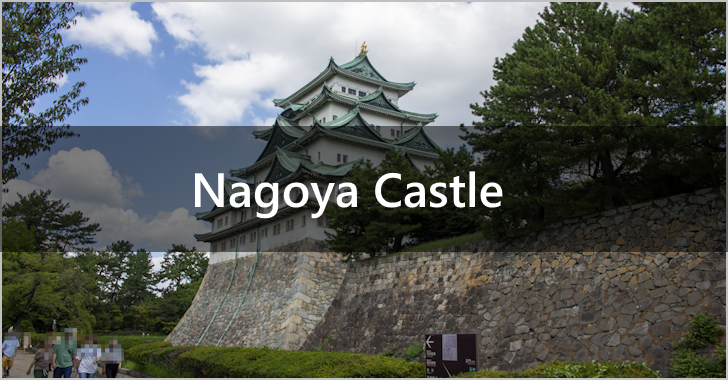
(Last modified: )
(Prefecture : Aichi , Category : Castles)
Table of contents
- Highlights of Nagoya Castle
- About Nagoya Castle
- Seimon
- Nishinomaru Okura Johokan
- Seinan-sumi Yagura
- Tounan-sumi Yagura
- Honmaru Omote Ni-no-mon
- Main Tower Keep
- Kinshachi
- Hommaru Palace
- Former Ni-no-maru Higashi Ni-no-mon
- Kiyomasa Stone
- Fumeimon
- Seihoku-sumi Yagura
- Nogi-soko
- Ninomaru Garden
- Ninomaru Ote Ninomon
- About eating and drinking inside Nagoya Castle
- Kinshachi Yokocho
- Meijo Park
- Snowy landscape of Nagoya Castle
- List of photos related to Nagoya Castle
- Address and access method of Nagoya Castle
- Attractions near Nagoya Castle
- Other information about Nagoya Castle
Highlights of Nagoya Castle
We will introduce the highlights of Nagoya Castle.
About Nagoya Castle
The location where Nagoya Castle stands originally housed Nagoya Castle(The reading is the same), built by the Imagawa clan during the Muromachi period. The castle's ownership transitioned from the Imagawa clan to the Oda clan, and later when Oda Nobunaga became the castle lord, it was once abandoned as he relocated his base to Kiyosu Castle. At that time, Kiyosu Castle became the focal point of Owari province.
After the Battle of Sekigahara, Kiyosu Castle was given to Tokugawa Ieyasu's fourth son, Matsudaira Tadayoshi, and after his death, it became the residence of Ieyasu's ninth son, Tokugawa Yoshinao. However, there were concerns about frequent flooding and other problems at Kiyosu Castle. Therefore, to prepare against the Toyotomi forces in Osaka, Tokugawa Ieyasu initiated the construction of Nagoya Castle as the new castle in Owari in 1610. The construction was ordered to be undertaken by daimyos loyal to Toyotomi, including Kato Kiyomasa and Fukushima Masanori, through a nationwide conscription known as "Tenka Bushin".
By 1612, the castle tower was completed, and by 1615, the Honmaru Palace was completed. Notably, 1615 was also the year of the Siege of Osaka Summer Campaign, which marked the end of the Toyotomi clan. Following the commencement of the construction of Nagoya Castle, there was a mass migration from Kiyosu Castle to Nagoya Castle, involving the relocation of entire towns. Consequently, the Owari domain was established, with Tokugawa Yoshinao becoming its first feudal lord.
Seimon
The Seimon(main gate) is located at the entrance of the West Enclosure, right next to the ticket booth. In the past, at the location where the Seimon now stands, there used to be a gate called Enokida-mon. This gate, along with Kabuki-mon on the south side, and Tamon Yagura towers on the north and west sides, formed a masugata-koguchi, a boxed-shaped defensive entrance.
During the Nobi Earthquake in 1891, the Enokida-mon was severely damaged. Subsequently, the Hasuike-mon from the former Edo Castle was relocated here but unfortunately, it was burned down during the air raids in 1945. The current Seimon was restored in 1959.
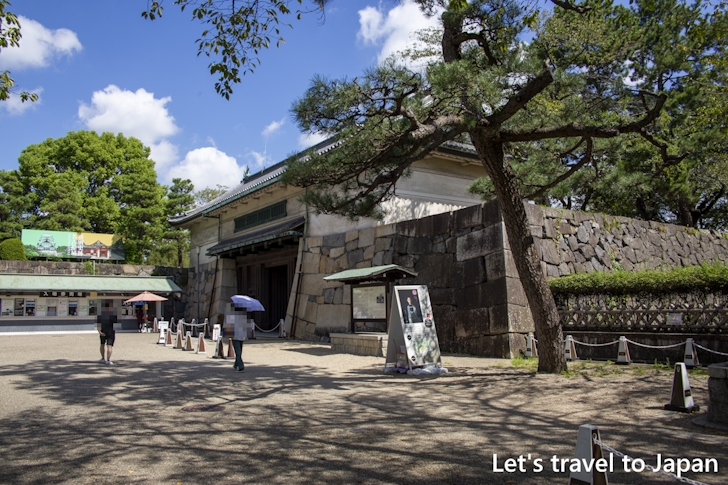

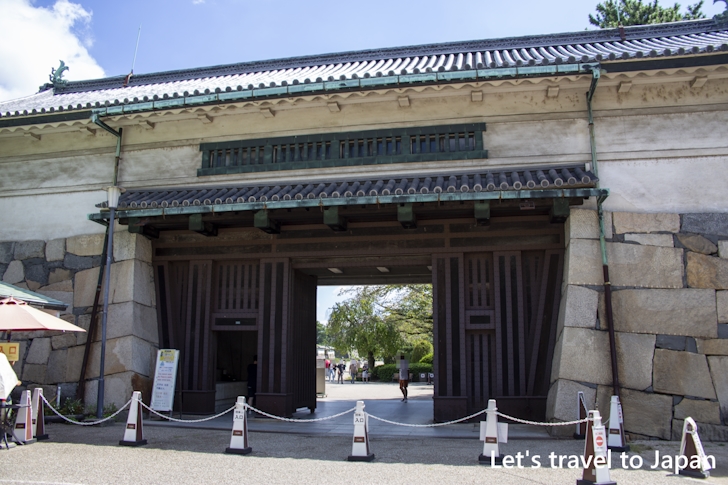
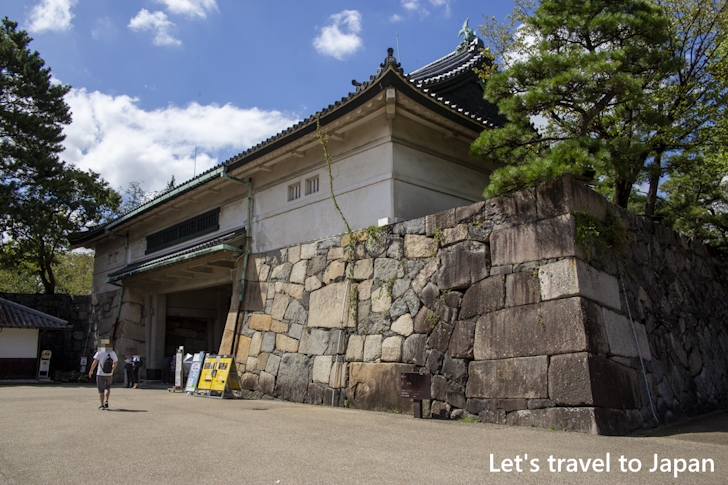
Nishinomaru Okura Johokan
Immediately to the left as you enter from the Seimon is the Nishinomaru Okura Johokan. It features an information room where you can learn about the history of Nagoya Castle, and it houses exhibitions of valuable cultural assets that are stored in Nagoya Castle. Moreover, the exterior of the Castle Treasure Hall replicates the appearance of a storehouse that originally stood in Nishinomaru.
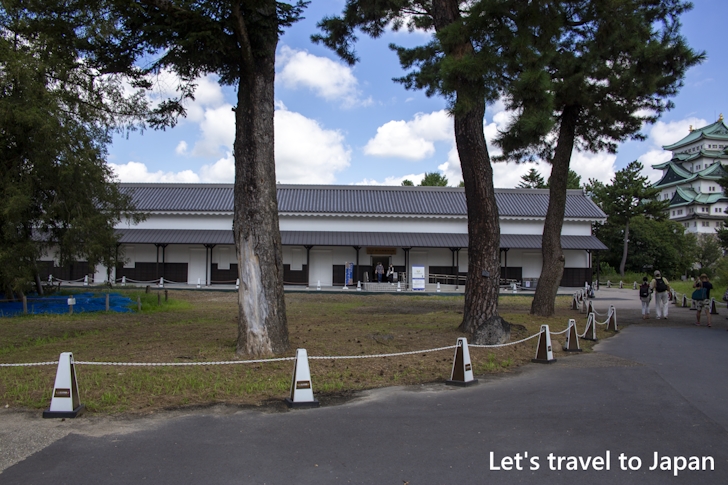
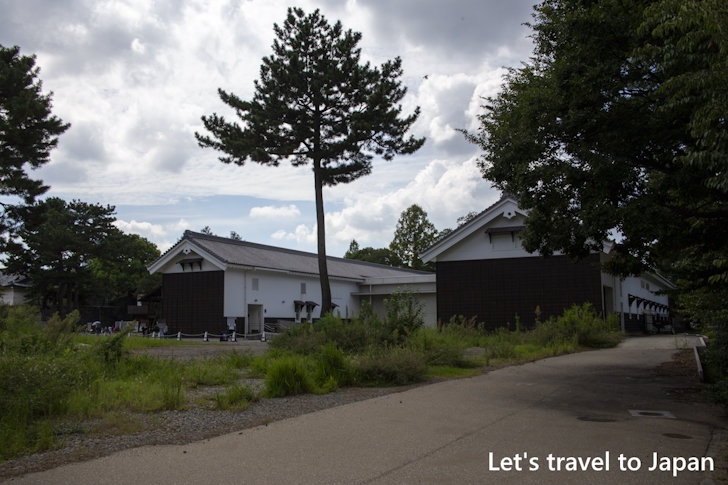
Seinan-sumi Yagura
The Seinan Sumi Yagura(Southeast Corner Watchtower) was built in 1612 and is located in the southwest of the Honmaru. It was called the Hitsujisaru Sumi Yagura. It has been designated as an Important Cultural Property. While it appears to be two stories from the outside, it has three floors inside. Although it collapsed once during the late Meiji to Taisho period, it has been rebuilt using old materials.
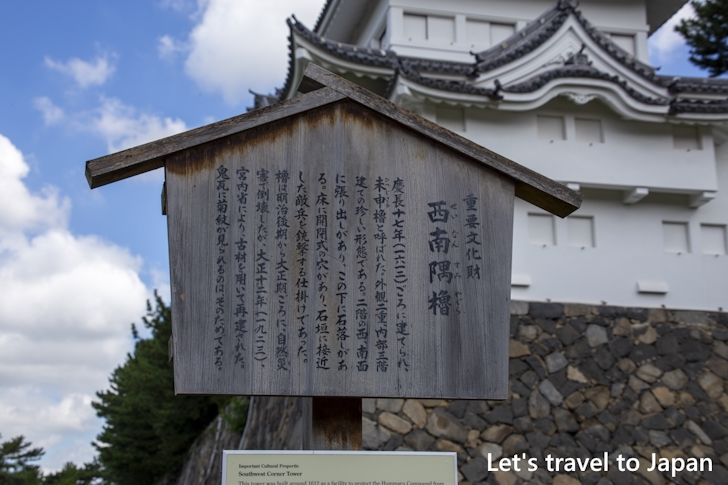
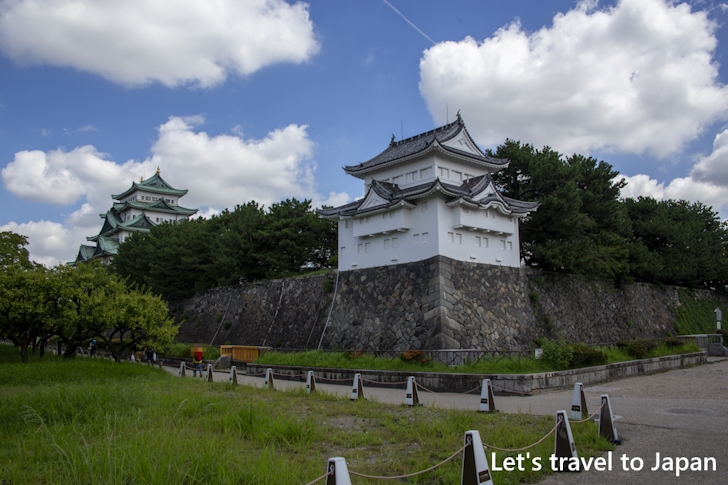
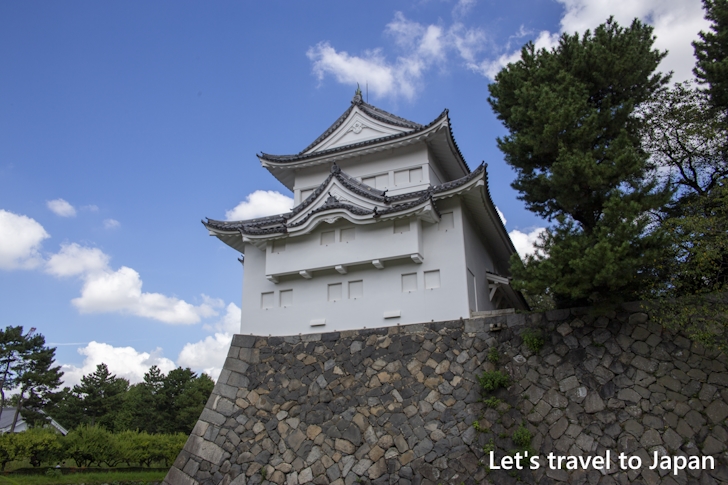
It can also be viewed from the Honmaru side.
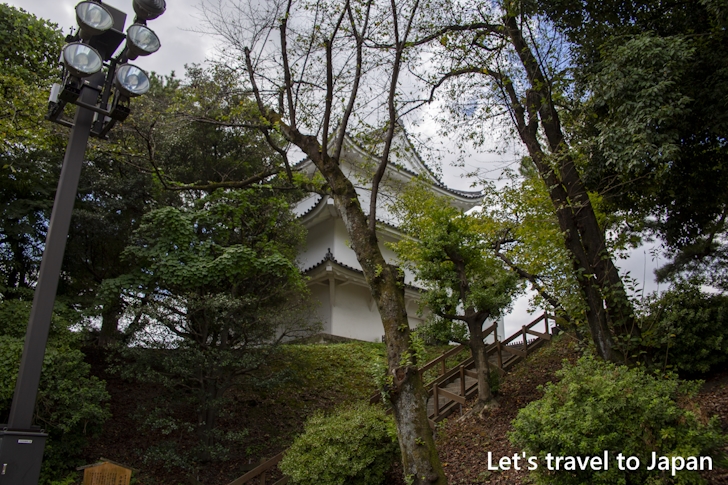
Tounan-sumi Yagura
The Tounan-sumi Yagura(Southeast Corner Watchtower) was built in 1612 and is located in the southeast of the Honmaru. It was called the Tatsumi Sumi Yagura. It has been designated as an Important Cultural Property. Like the Southeast Corner Turret, it appears to be two stories from the outside, but it has three floors inside. During the dismantling and repair in Showa 27 (1952), it was discovered that a Shachihoko from the Edo Castle during the Meiji era had been attached to it.
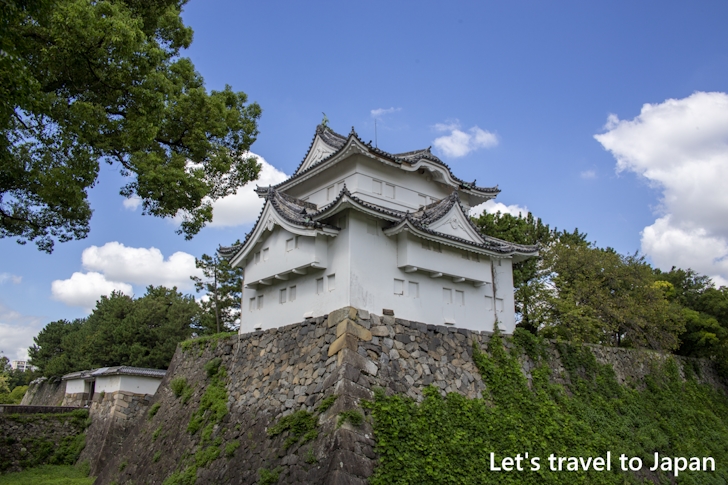
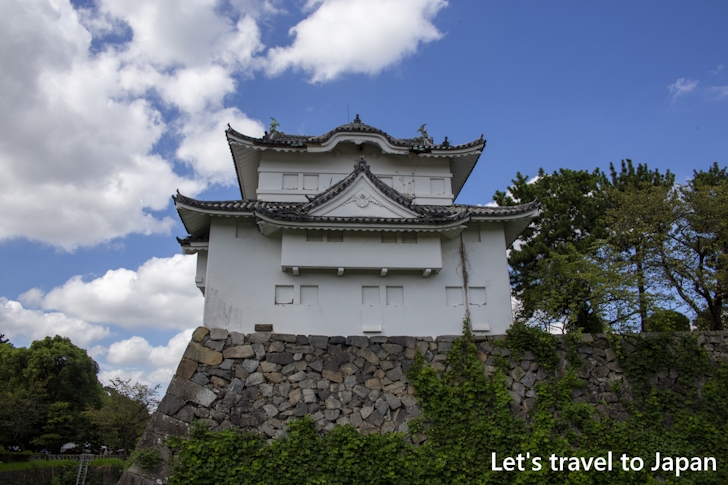
It can also be viewed from the Honmaru side.
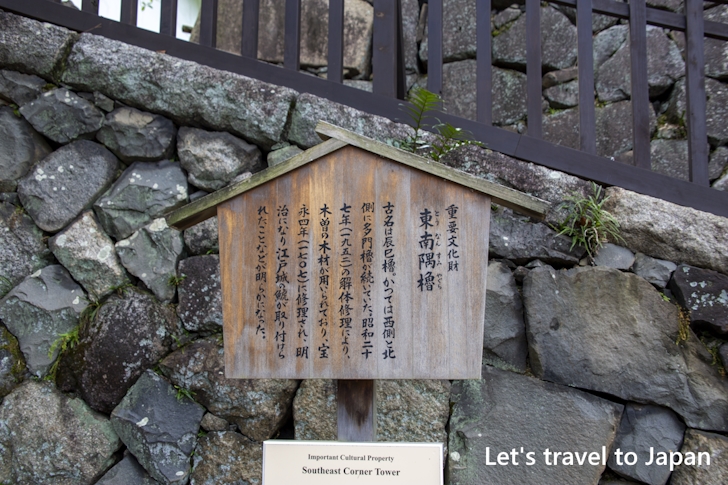
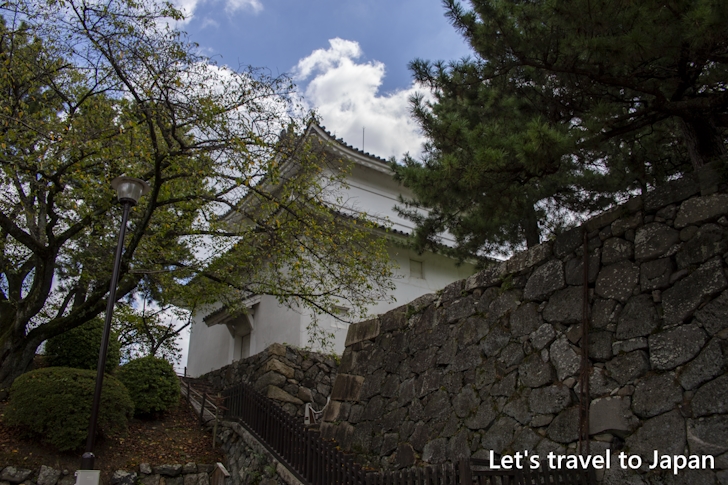
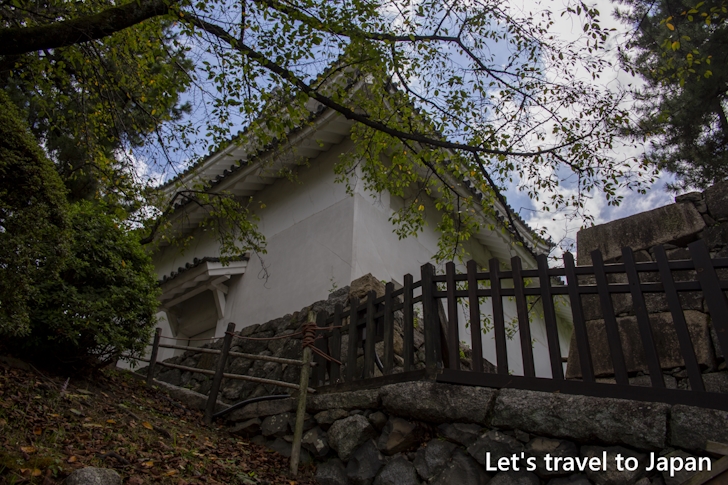
Honmaru Omote Ni-no-mon
The Honmaru Omote Ni-no-mon(Second Front Gate) is a gate that has survived since the founding of Nagoya Castle and has been designated as an Important Cultural Property. It was previously called the South Ninomon and, together with the now non-existent Omote Ichinomon, formed a masugata (a type of defensive gateway).
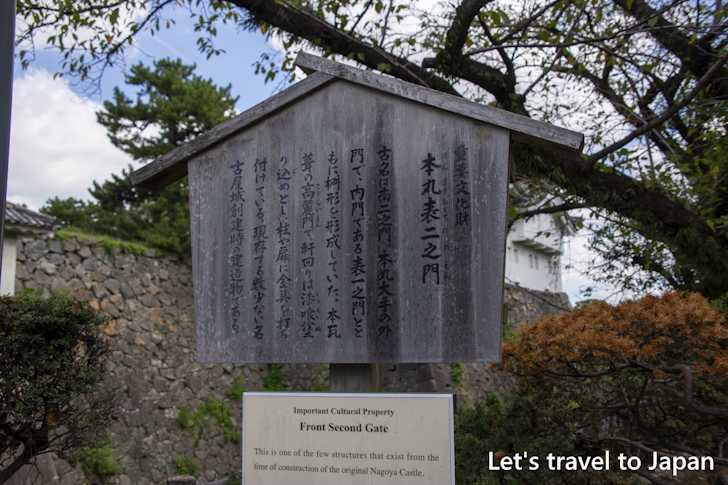
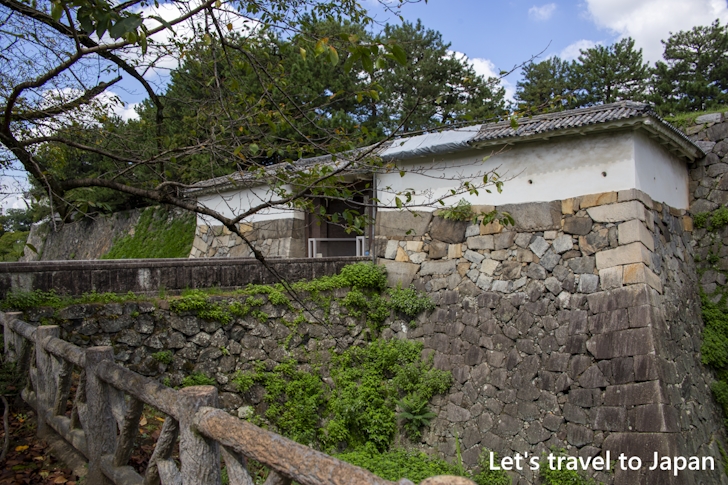
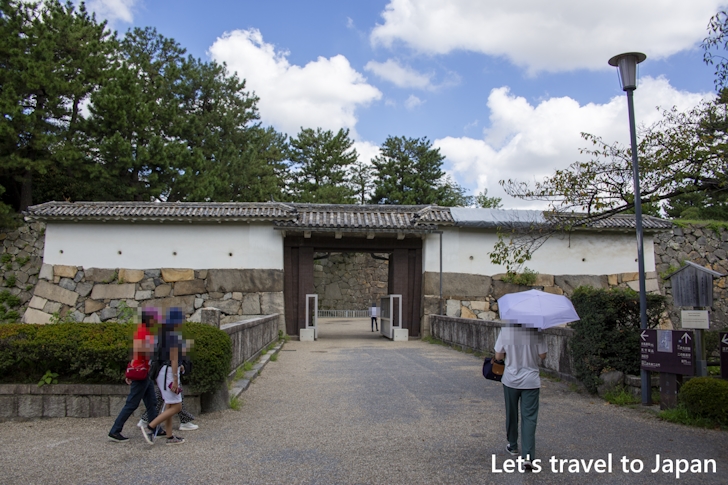

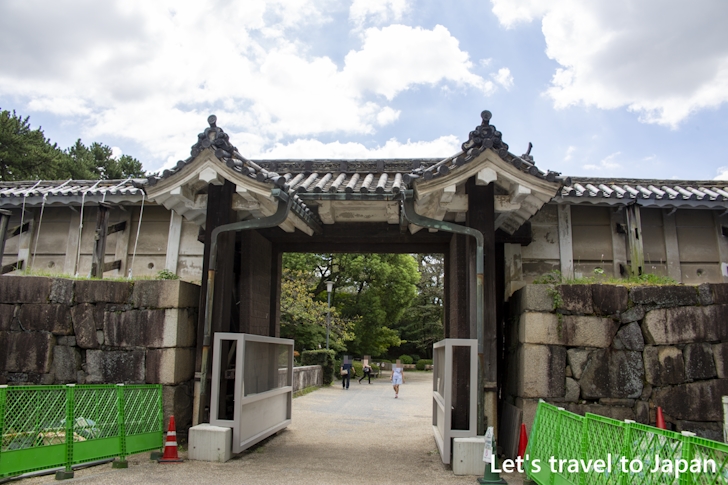
Main Tower Keep
The Main Tower Keep of Nagoya Castle consists of the large main tower and a smaller tower, which are connected by a turret base (Yaguradai).
Large castle tower:

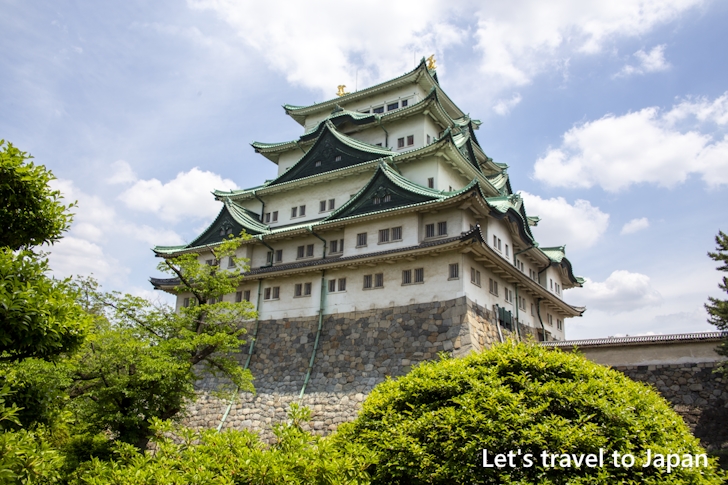
Small castle tower:
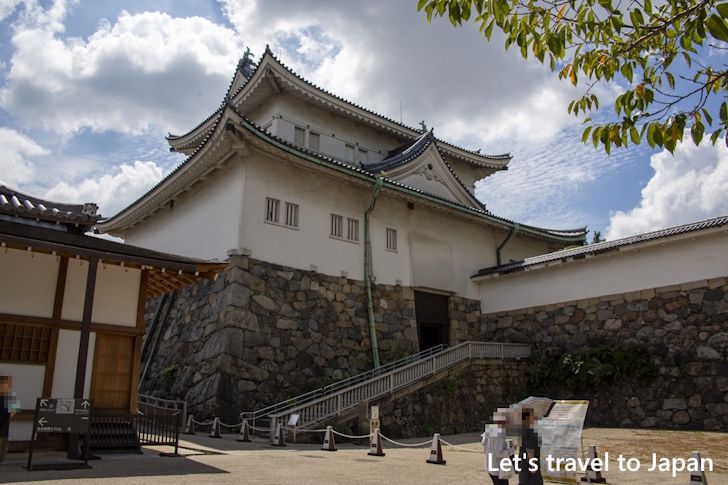
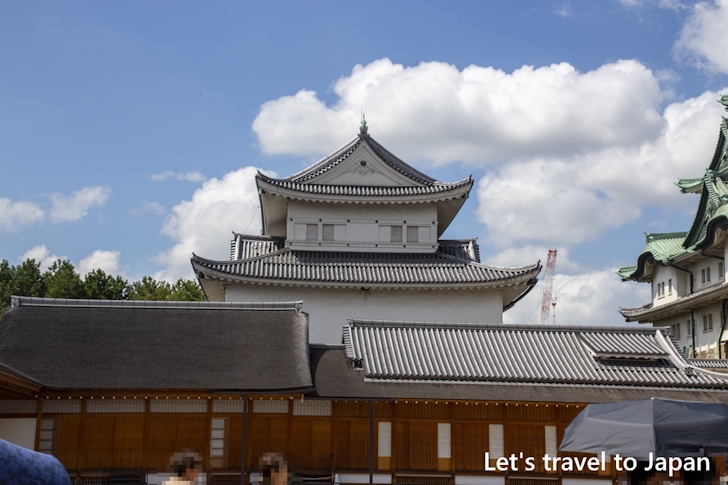
The turret base connecting the large and small main towers is surrounded by high earthen walls, and the eaves of the moat were lined with spear tips to prevent enemy invasions. Due to this, it is called Tsurugibei (sword wall).
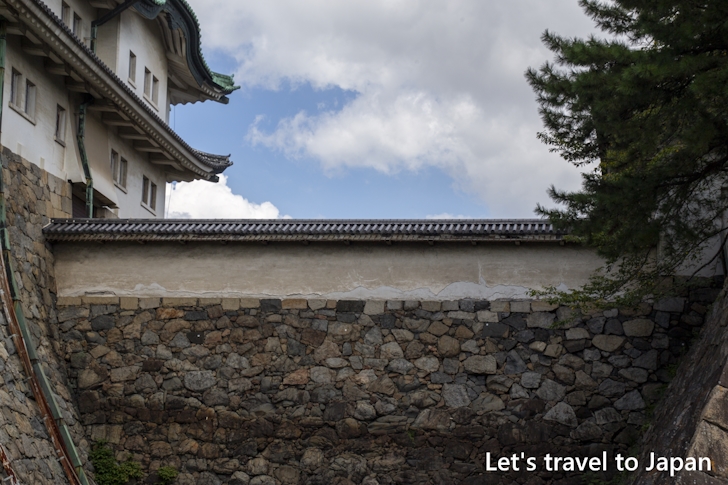
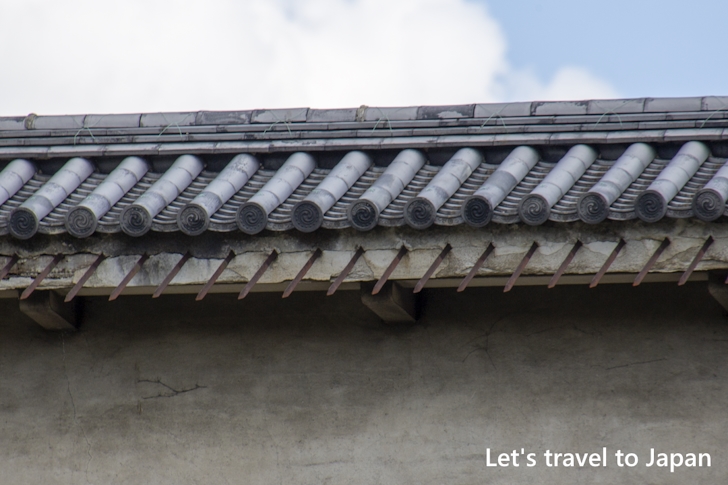
Both of the main towers were completed in 1612 and remained intact through the Edo, Meiji, and Taisho periods. In 1930, they were designated as National Treasures, but sadly, they were burned down in the air raids of 1945. After the war, they were reconstructed with reinforced concrete. As of 2023, entry to the main towers is prohibited due to seismic resistance issues. Plans are underway to rebuild them again with wooden construction in the future.
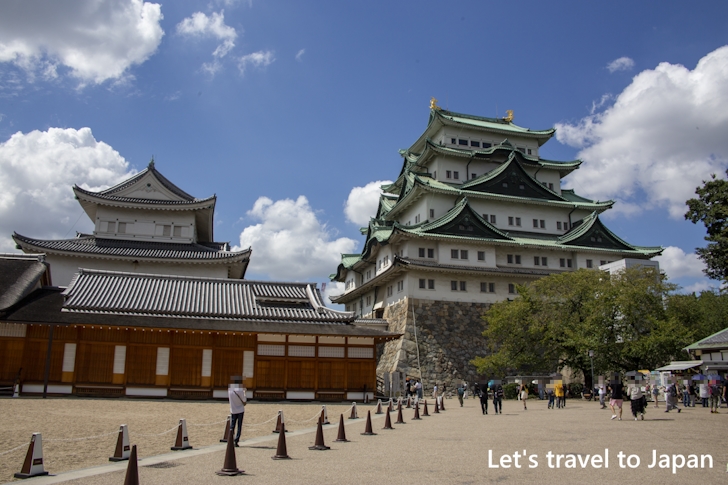
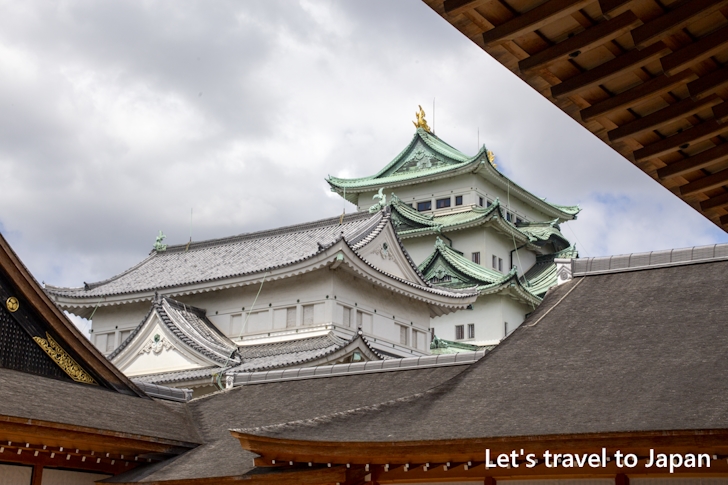
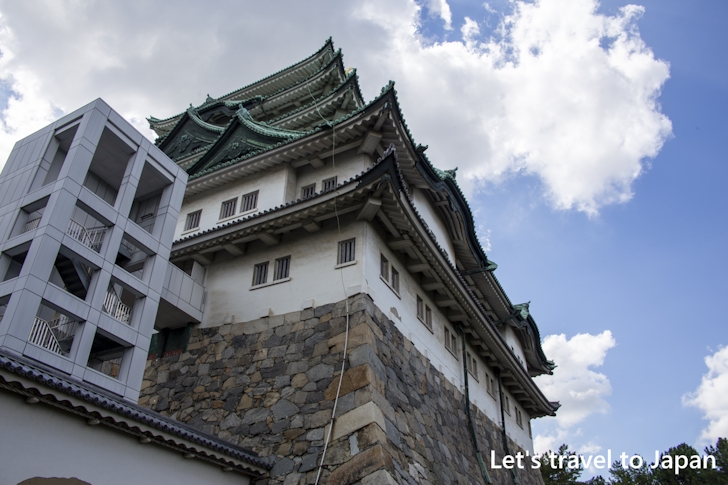
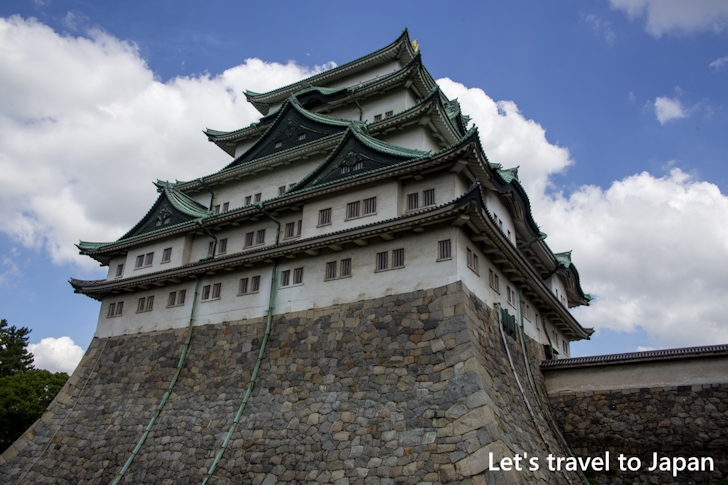
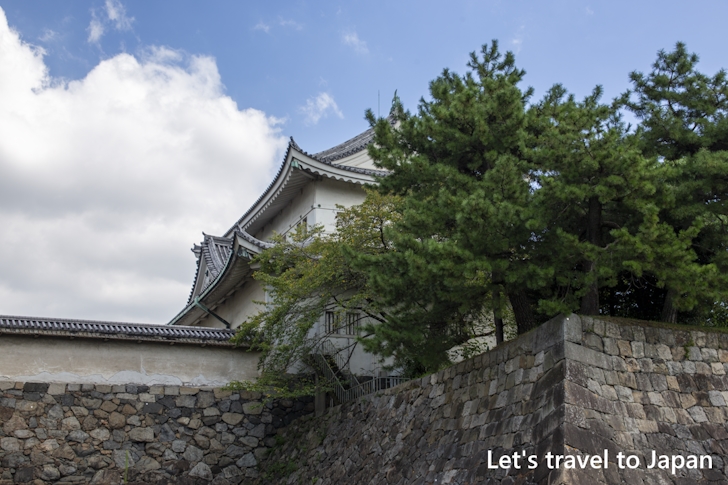
Kinshachi
Nagoya Castle is famous for its golden Shachihoko (Kinshachi), also known as Golden Tiger-Fish Roof Ornaments. On the north side of the main tower is the male, and on the south side is the female. At the time of its construction in 1612, 215 kg of pure gold was used, but due to financial difficulties and other reasons, it has been remade several times, reducing the amount of gold each time. Like the main tower, they were destroyed in the 1945 fire but were restored in 1959.
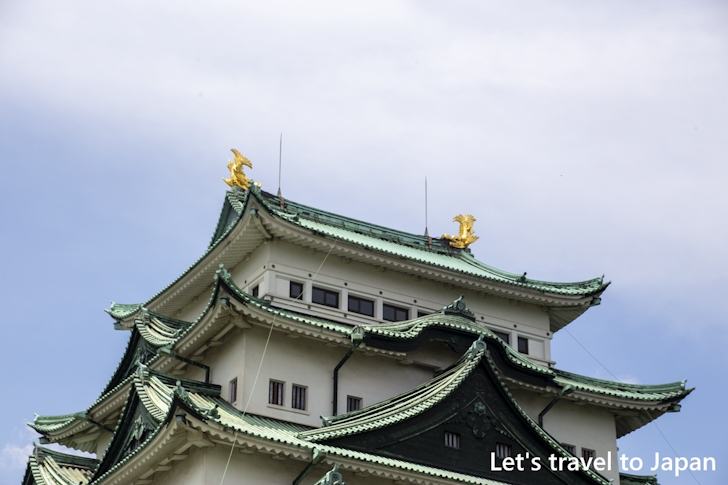
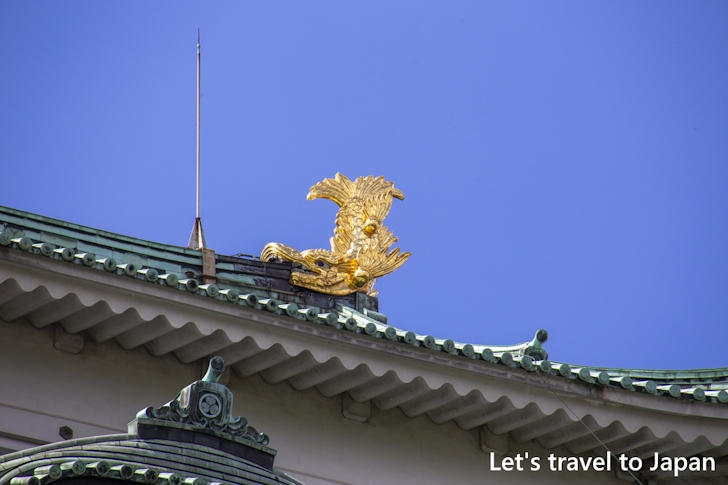
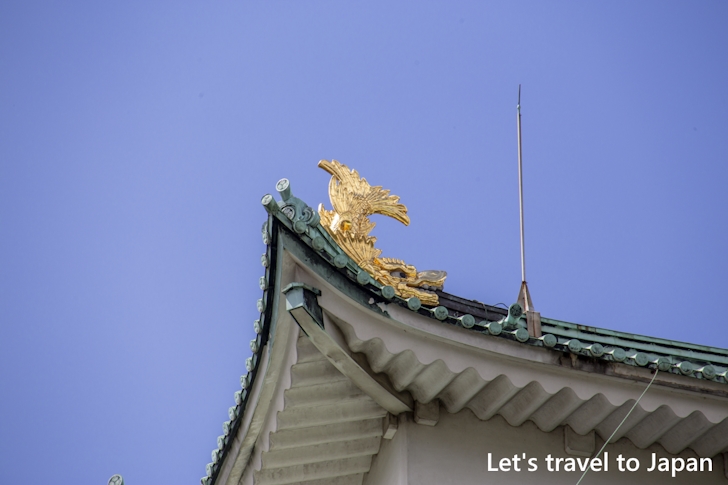
Inside "Shachi Jojo", a souvenir shop located in the Kinshachi Yokocho next to Nagoya Castle, life-sized golden Shachihoko are on display.
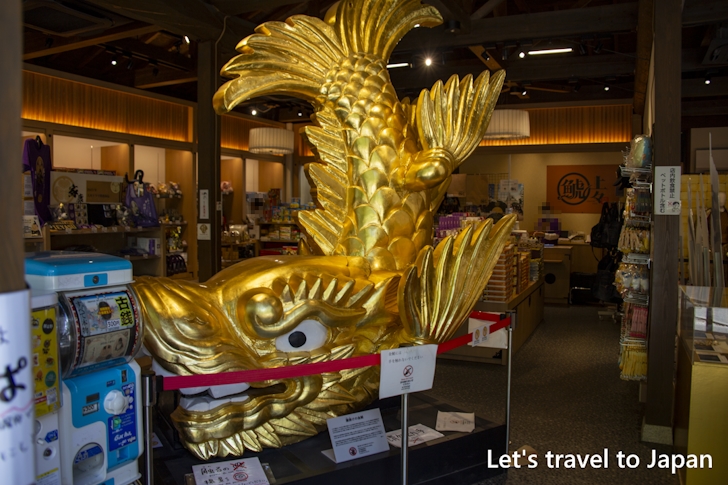
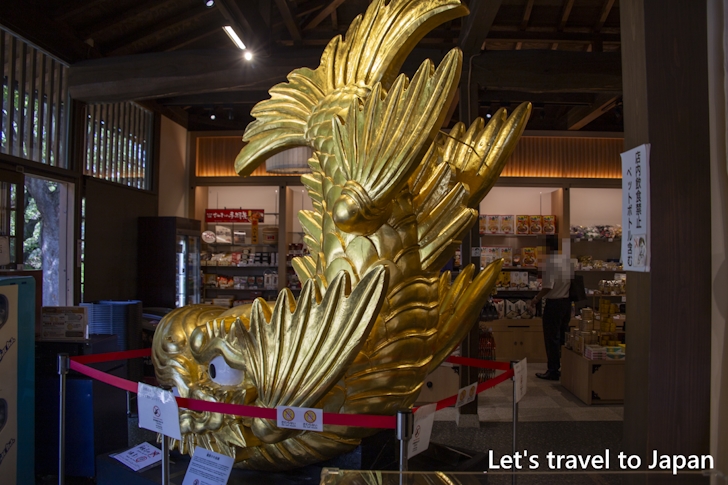
Hommaru Palace
The Honmaru Palace was completed in 1615 and served as the residence of the first lord of the Owari domain, Tokugawa Yoshinao, as well as the administrative office of the Owari domain. Later on, the palace also served as the Onari Goten, a place where the shogun would stay during his trips to Kyoto.
Like the main tower, it was unfortunately destroyed in the fire of 1945, but it was restored in 2018. Fortunately, fusuma paintings and ceiling board paintings managed to escape the fire, with 1,047 out of the existing 1,049 pieces being designated as important cultural properties.
For more detailed information about Hommaru Palace, please see 「Complete guide to the highlights of Nagoya Castle Honmaru Palace」.
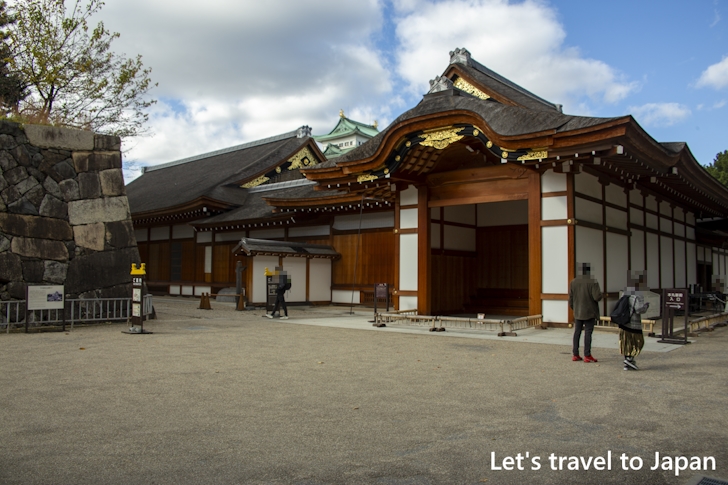
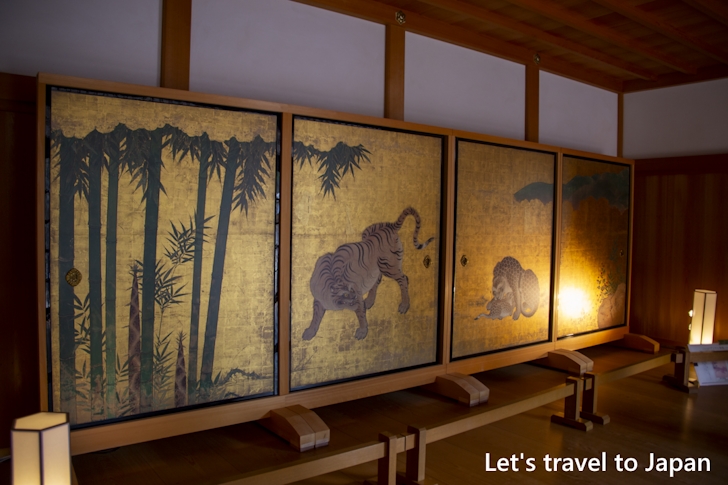
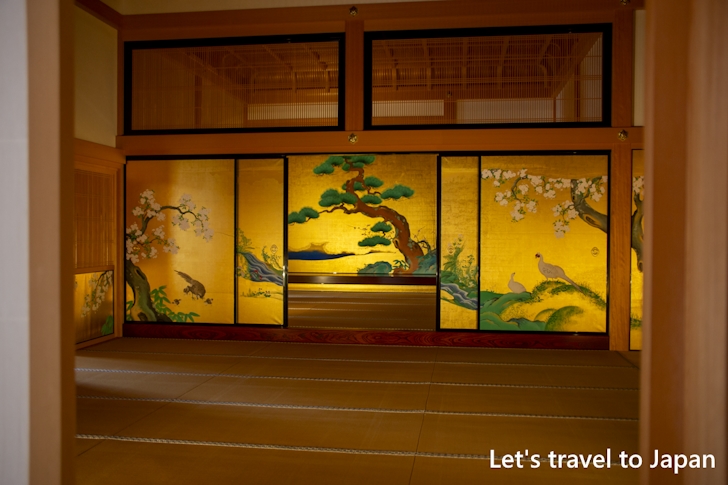
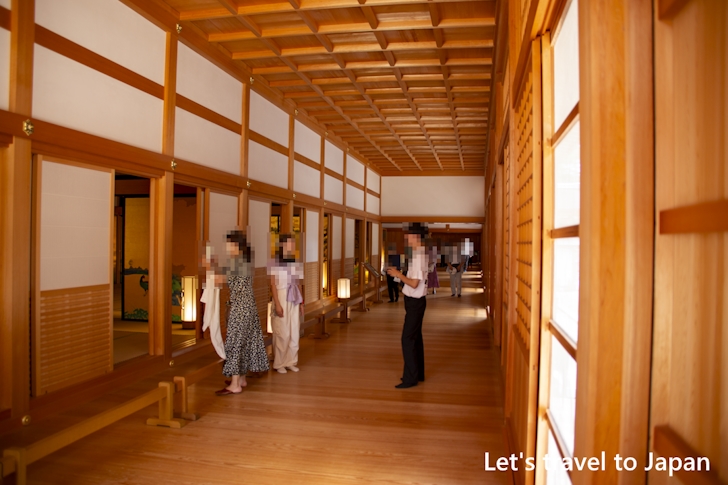

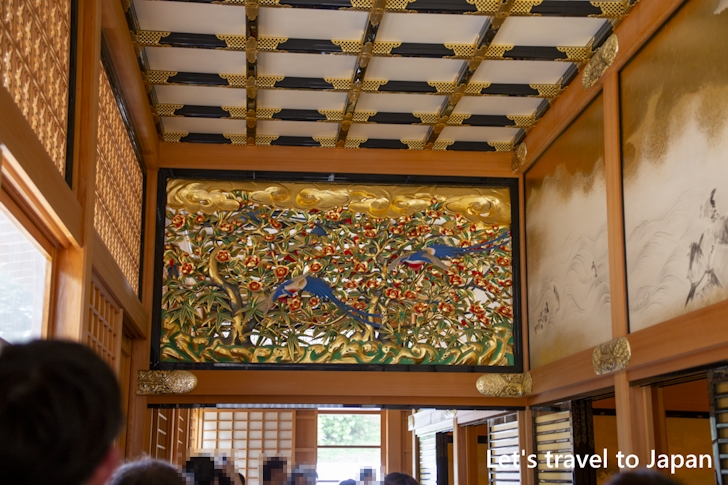
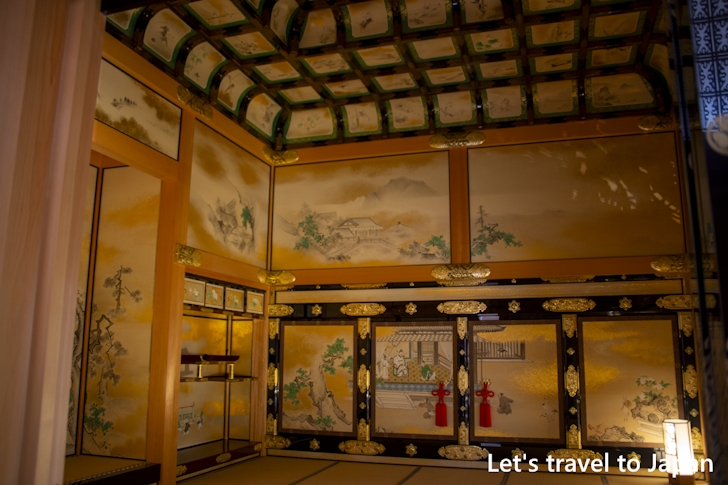
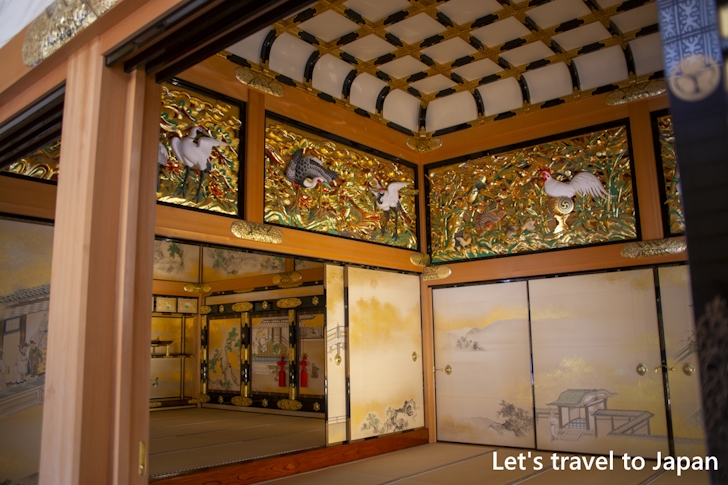
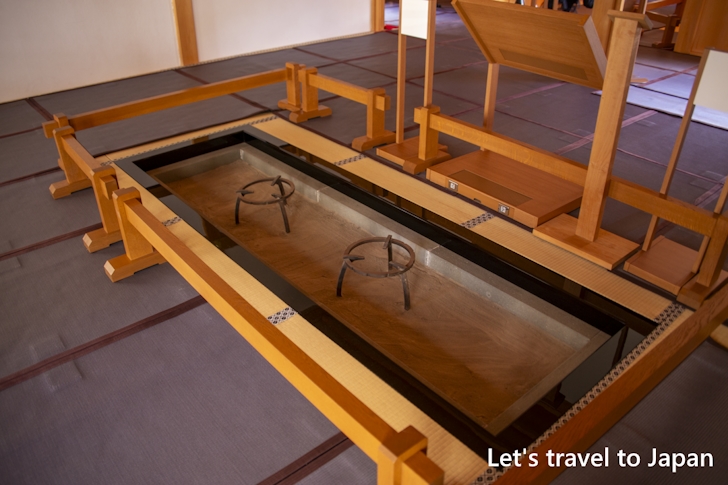
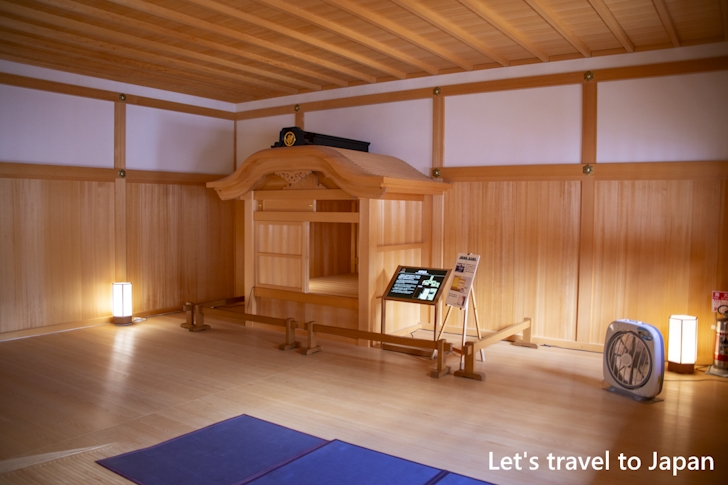
Former Ni-no-maru Higashi Ni-no-mon
The Former Ni-no-maru Higashi Ni-no-mon was constructed around 1612. Originally built as the Ninomaru Higashikuroganemon, it was relocated to its current location when the Aichi Prefectural Gymnasium was built in Ninomaru. On the stone wall in front of the Higashi Ni-no-mon, there is a Kiyomasa stone.
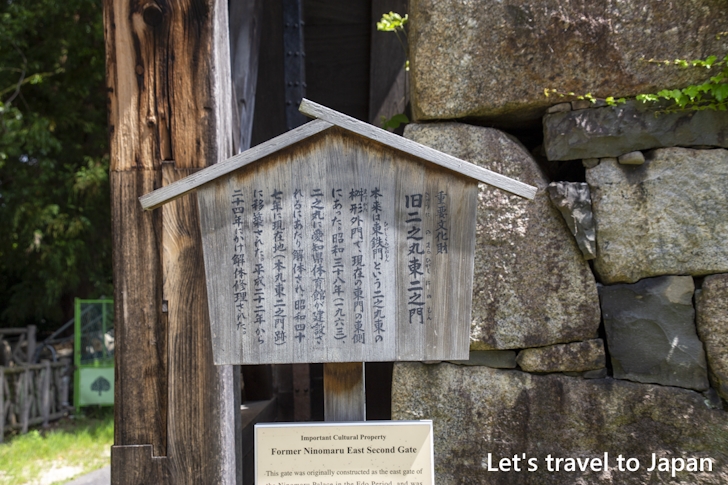
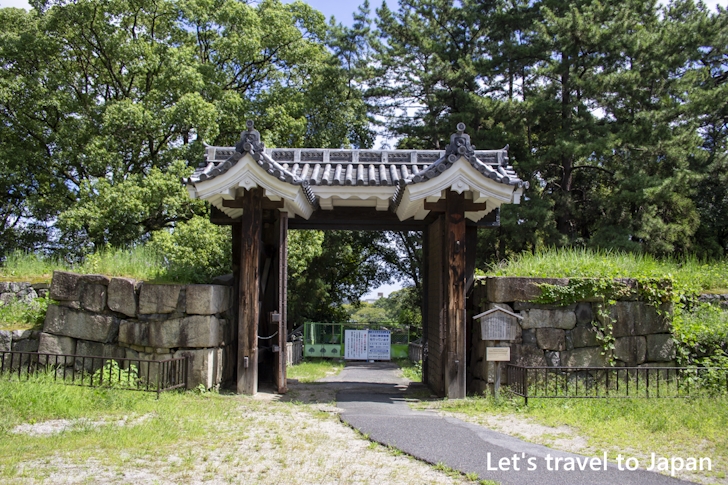
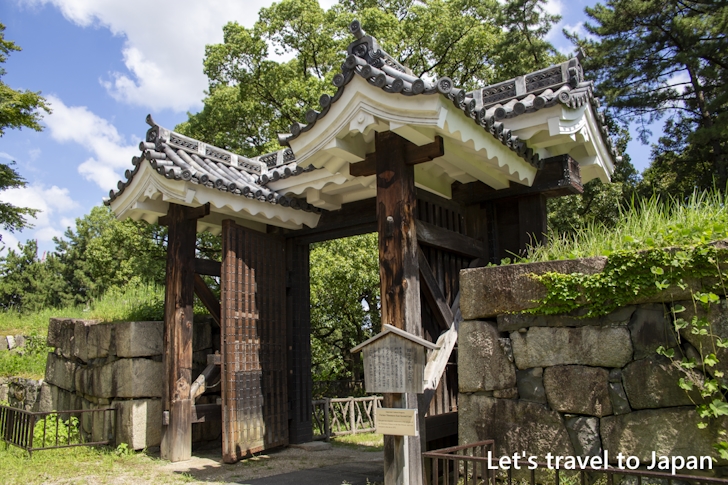
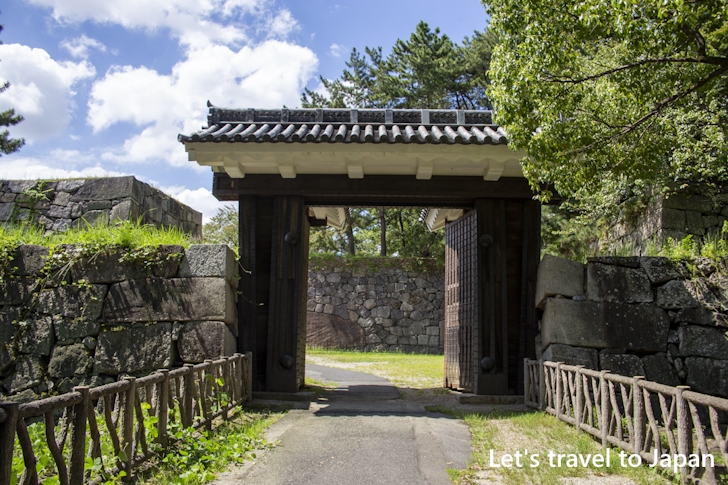
Kiyomasa Stone
The Kiyomasa stone is the largest boulder in the stone walls of Nagoya Castle. It is located in front of the Former Ni-no-maru Higashi Ni-no-mon, and weighs approximately 10 tons. The name comes from the belief that it was transported by Kato Kiyomasa, who was famous as a master builder of stone walls, although it seems this is not true since the person in charge of this stone wall was Kuroda Nagamasa.
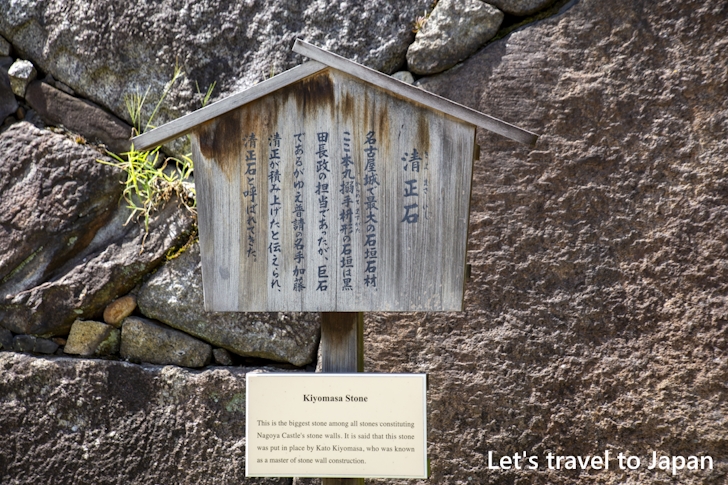
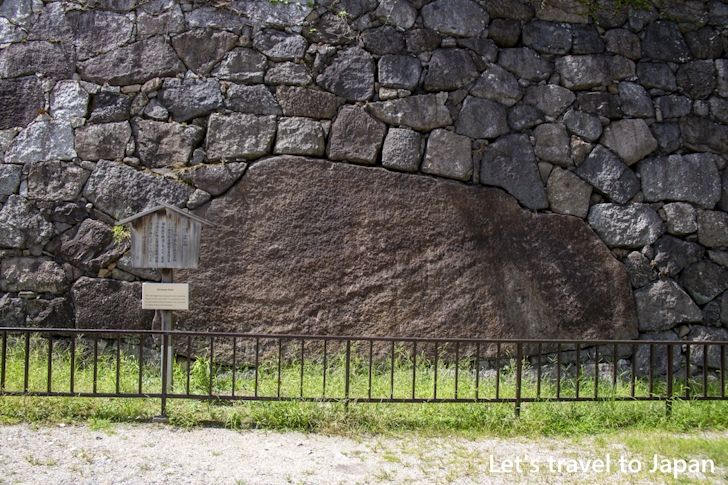
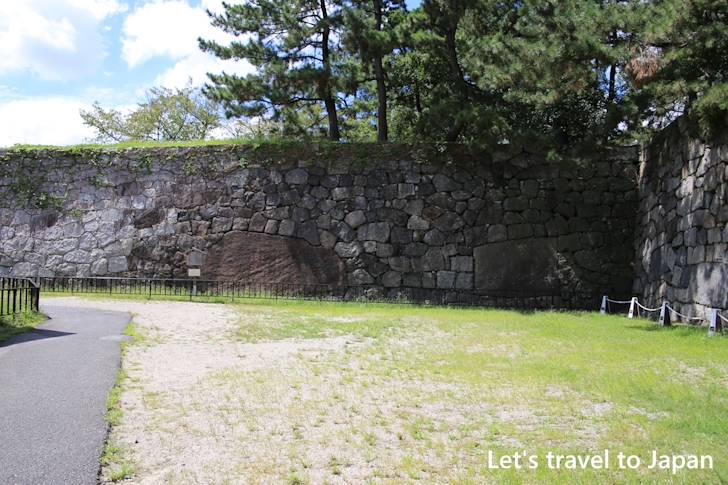
Fumeimon
The Fumeimon is a gate situated between the main citadel's north side and the Ofukemaru. It was located beneath a mud wall and was called "Akazunomon" because it was always tightly locked. Like the castle tower, it was destroyed in a fire in 1945, but it has since been restored.
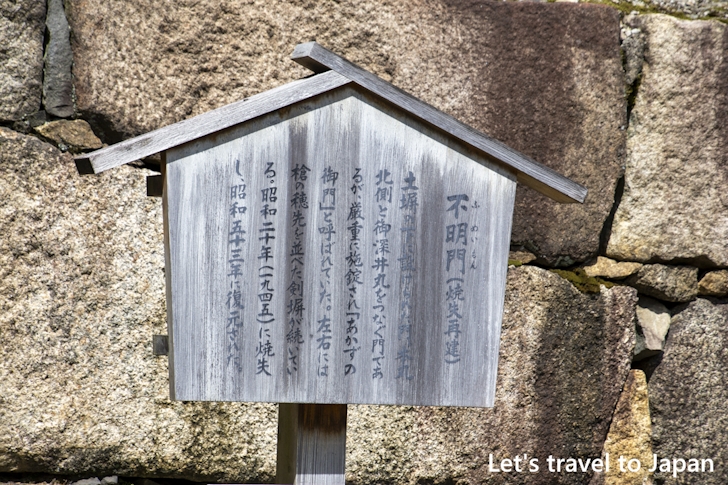
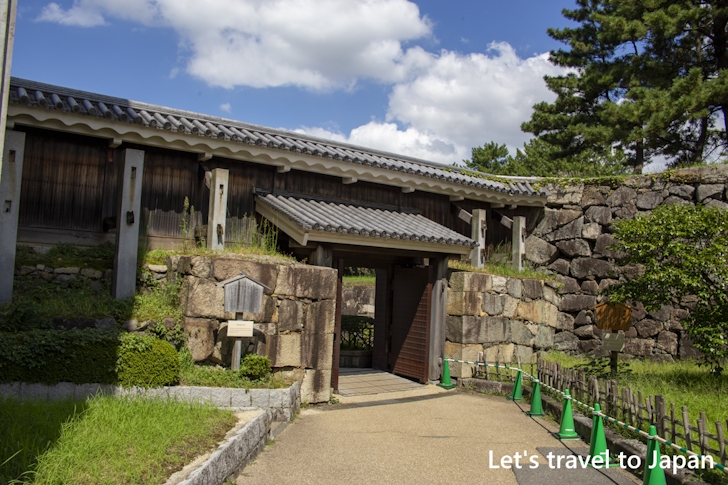
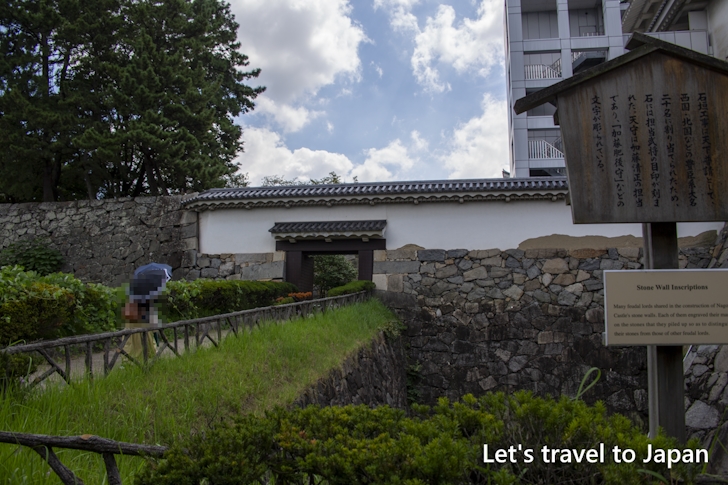
Seihoku-sumi Yagura
The Seihoku-sumi Yagura(Northwest Corner Watchtower) was constructed in 1619 and is located in the northwest of Ofukemaru. It was referred to as the Inui Sumiyagura. It has been designated as an Important Cultural Property. The exterior has three layers, and the interior is built with three floors, making it the second-largest three-story corner tower in the nation.
It is said that the Seihoku-sumi Yagura was relocated from the castle tower of Kiyosu Castle, and it is also called Kiyosu Yagura.
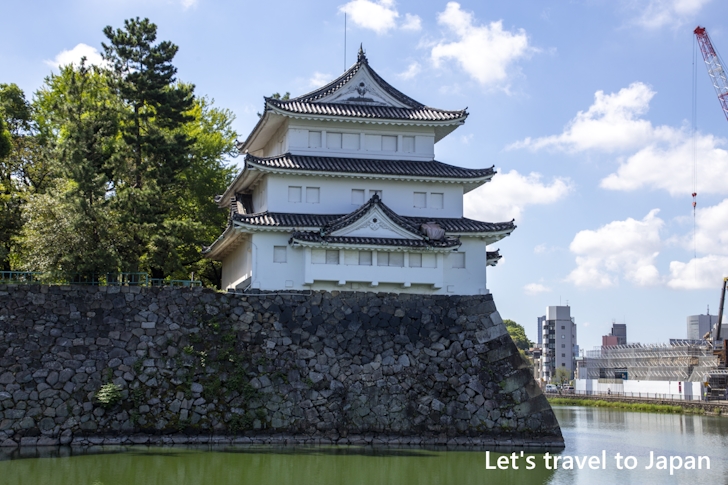
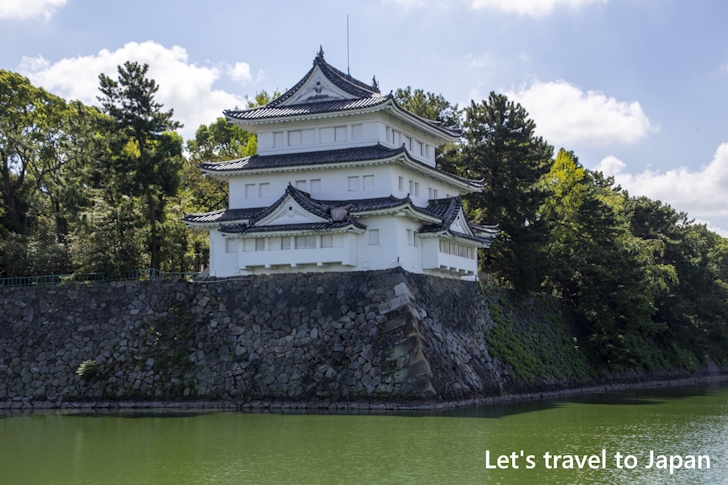
It can also be viewed from the Ofukemaru side.
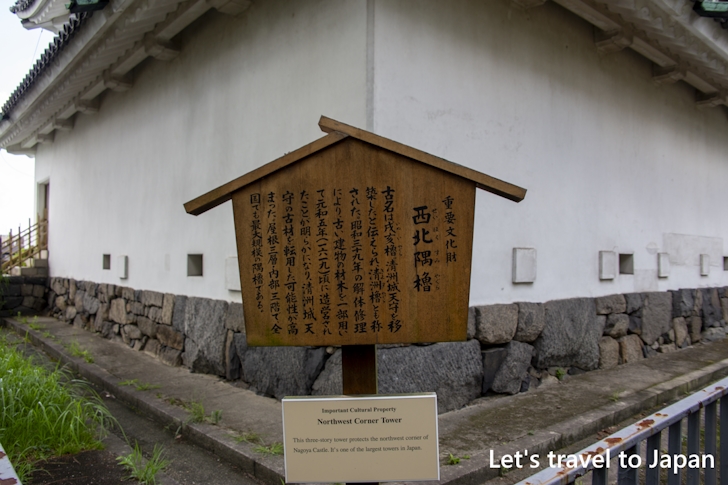
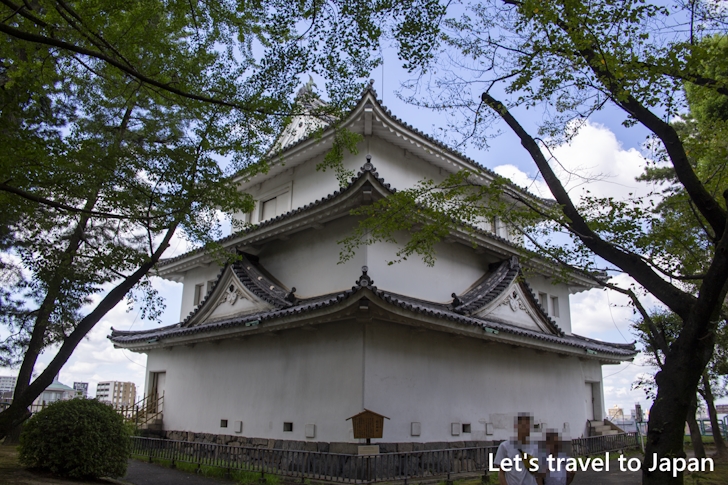
Nogi-soko
The Nogi-soko is a brick-built warehouse constructed in the early Meiji period. It was built during a time when it was used by the military, serving as an ammunition depot. It still exists in its original state.
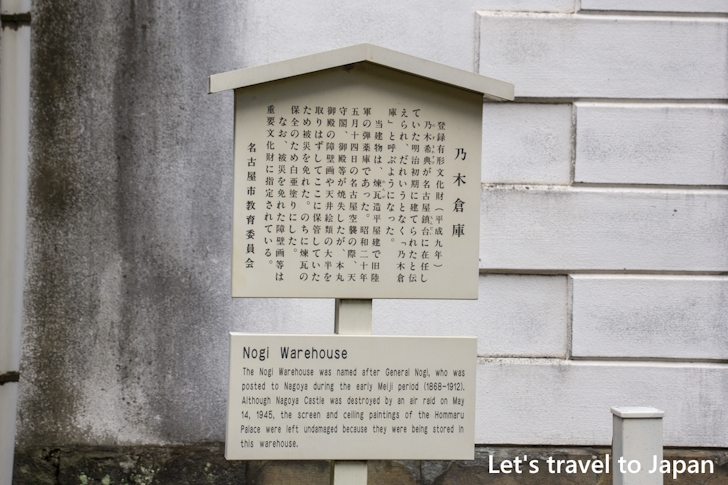
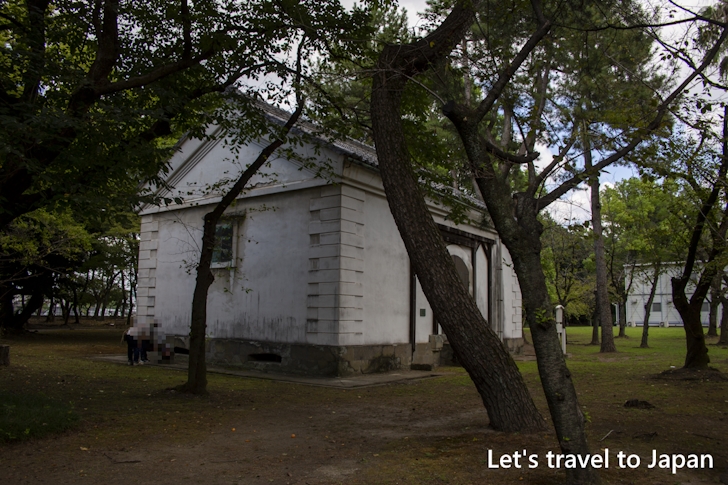
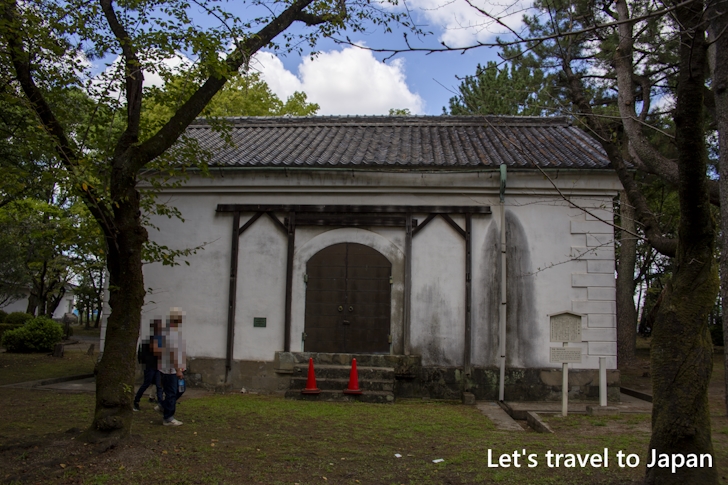
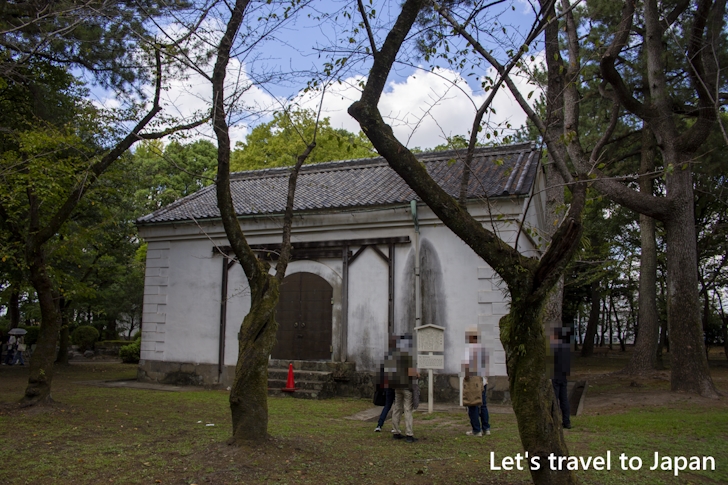
Ninomaru Garden
The lord of the Owari Domain lived in the Ninomaru Garden, and the garden built on its north side is the Ninomaru Garden. The Ninomaru Garden is broadly divided into the Maeniwa, the Kitaoniwa, and the Ninomaru East Garden. The extensive grounds include a tea house, garden pond, and artificial hills, with almost the entire area designated as a Meisho.
For more detailed information about Ninomaru Garden, please see 「Complete guide to the highlights of Nagoya Castle Ninomaru Garden」.
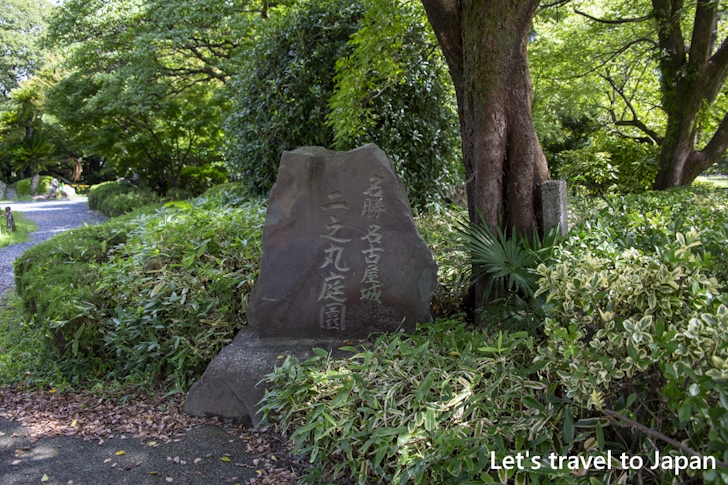
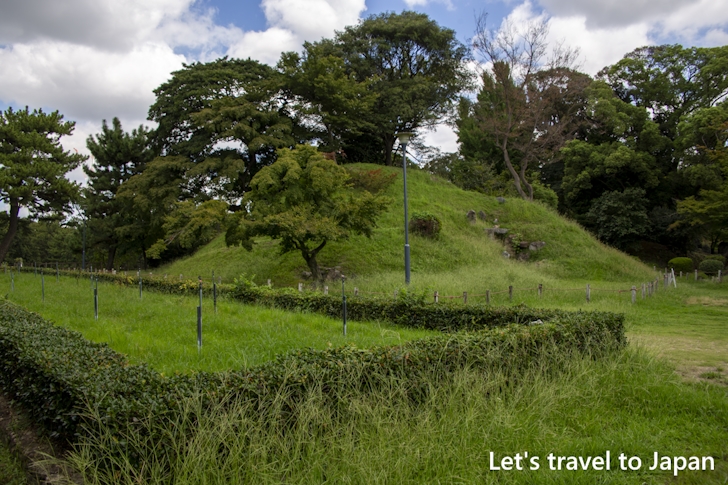
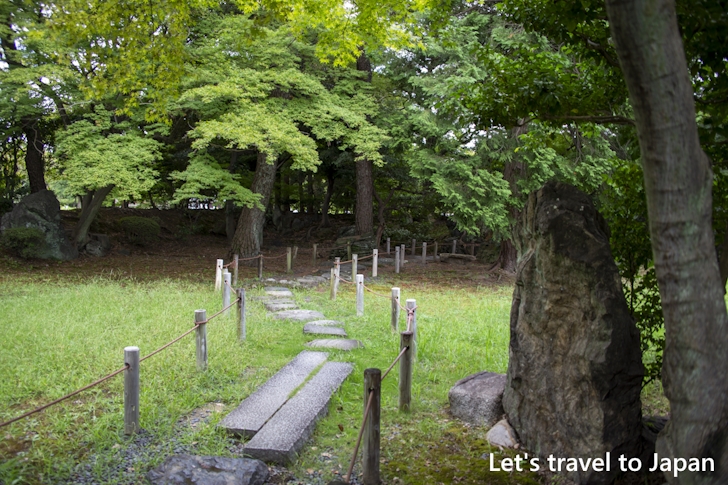
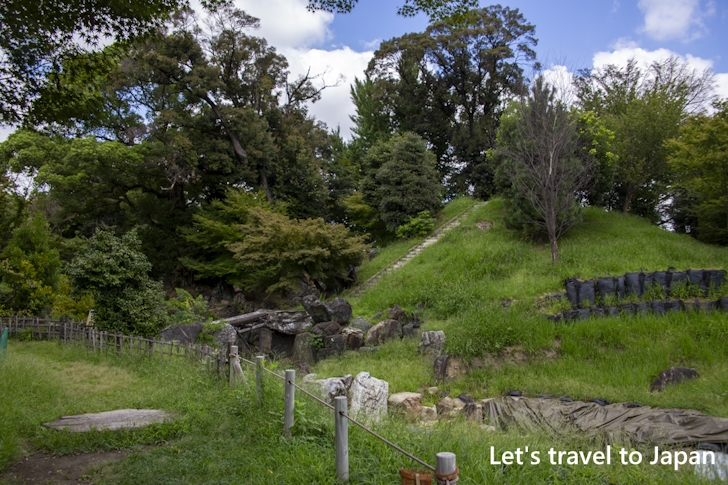
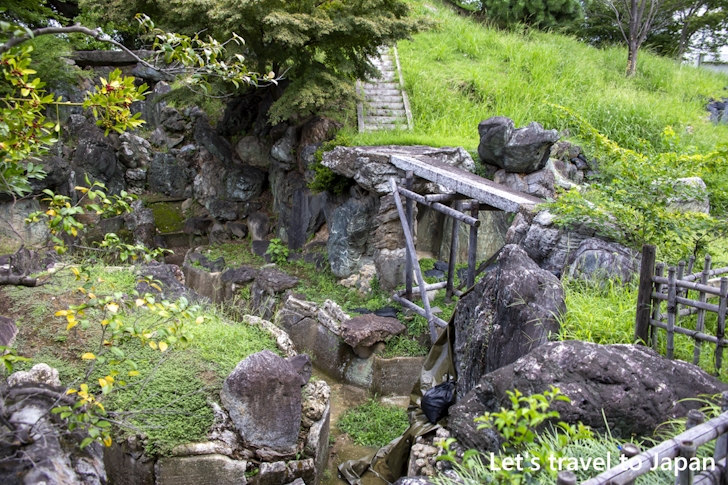
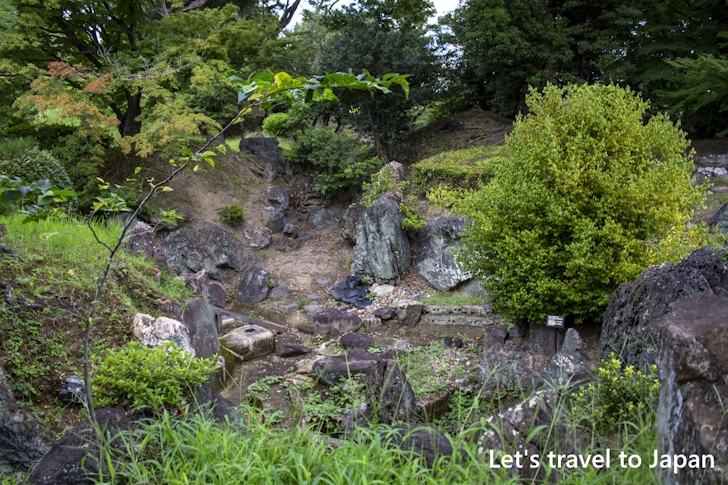
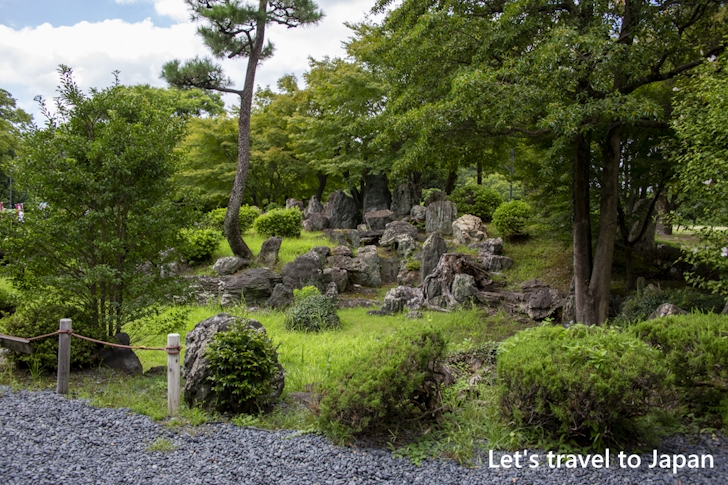
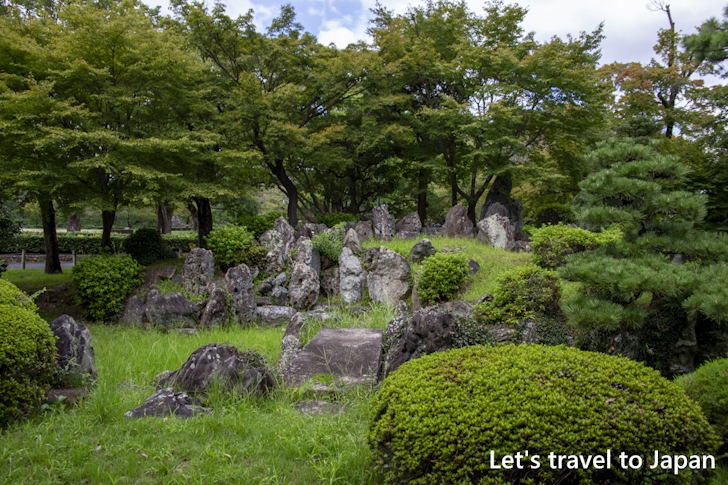
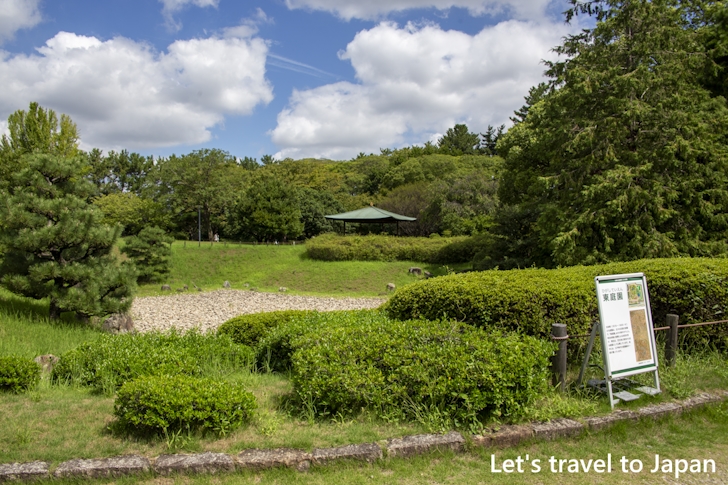
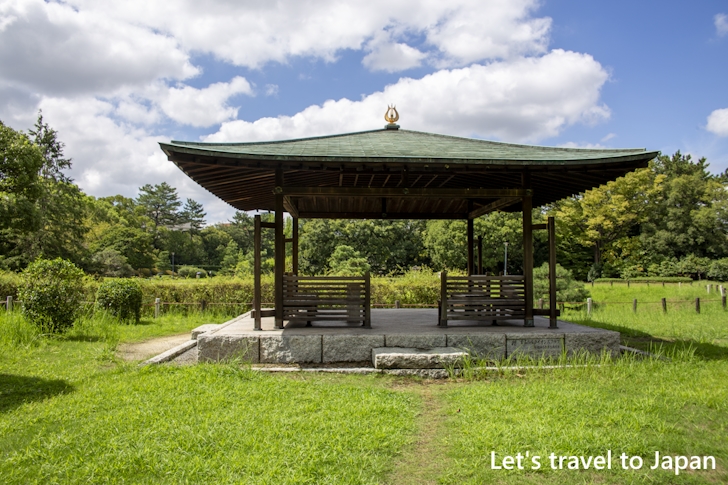
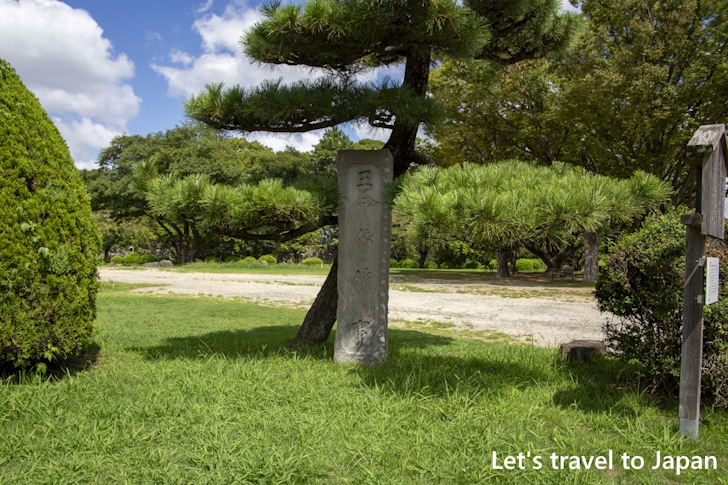
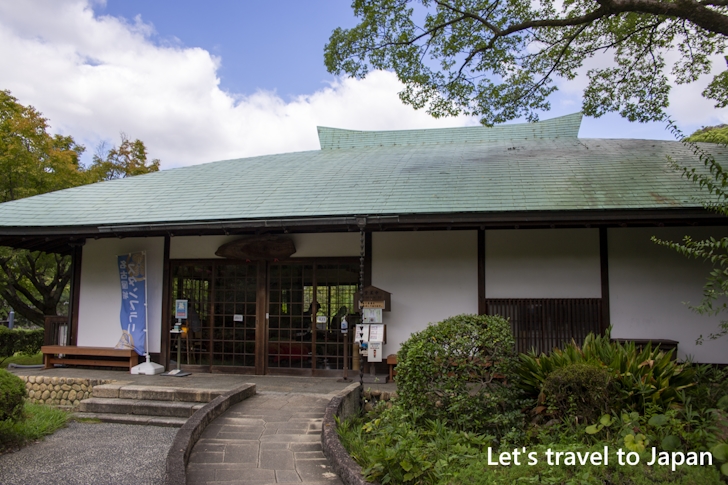
Ninomaru Ote Ninomon
The Ote Ninomon was the masugata outer gate located on the west side of the Ninomaru. Together with the inner gate, Ote Ichinomon (which no longer exists), they formed the Seimon to the Ninomaru. It has been designated as an Important Cultural Property.
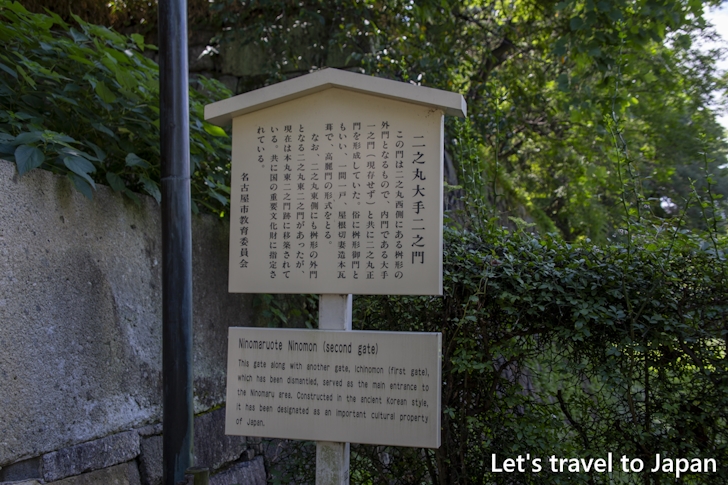
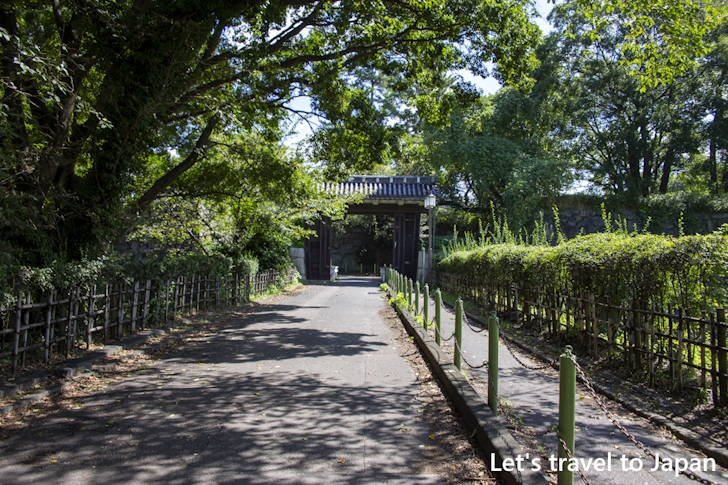
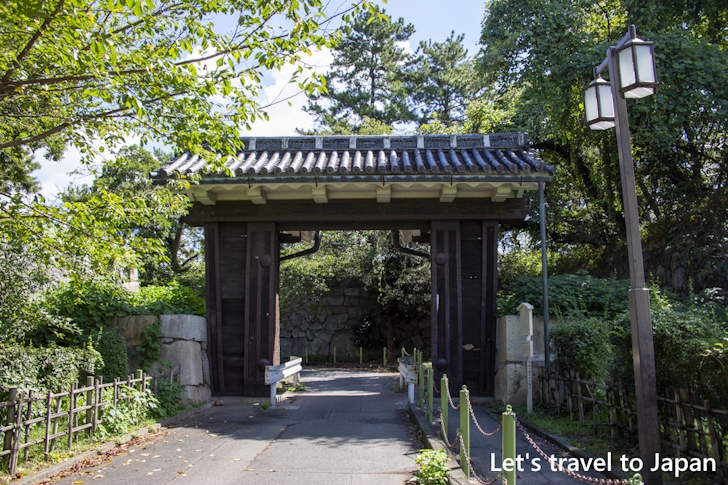
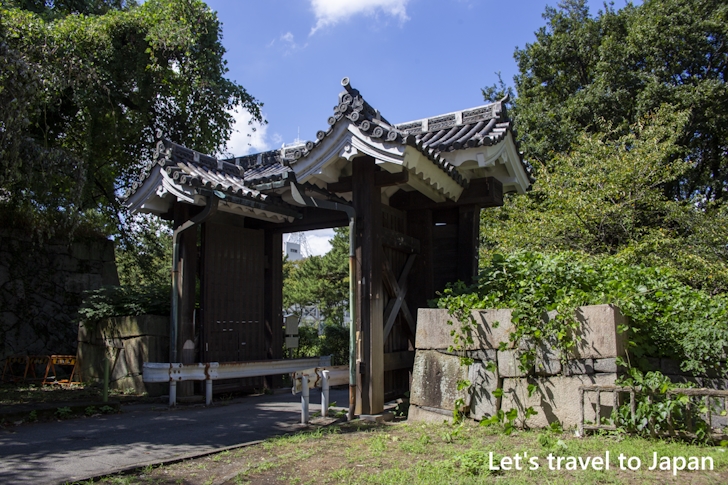
About eating and drinking inside Nagoya Castle
According to the 'Frequently Asked Questions' section on the official website of Nagoya Castle, outdoor dining areas such as Ninomaru Plaza are available for use. Additionally, upon confirmation via telephone, it was confirmed that bringing and eating your own lunch boxes is not a problem. (When eating in the plaza, it's requested that care is taken not to damage the grass, and it was noted that there are few covered areas, so it might be difficult in case of rain).
Ninomaru Square:
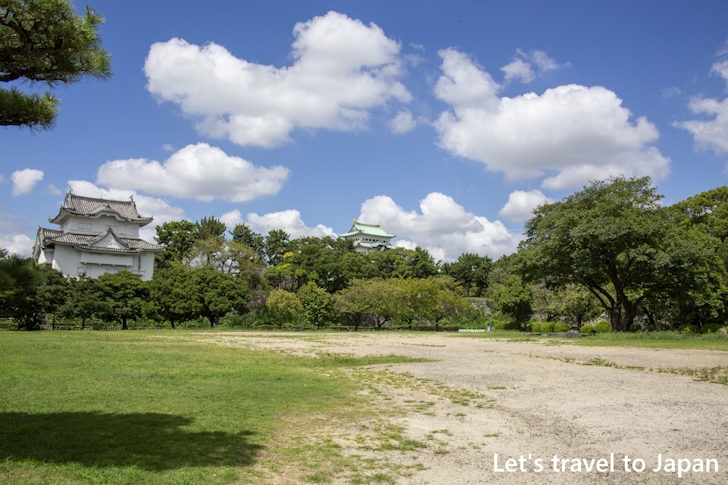
Additionally, inside Nagoya Castle, there is a noodle restaurant where you can enjoy kishimen. It is located right in front of the Honmaru Omote Ni-no-mon.
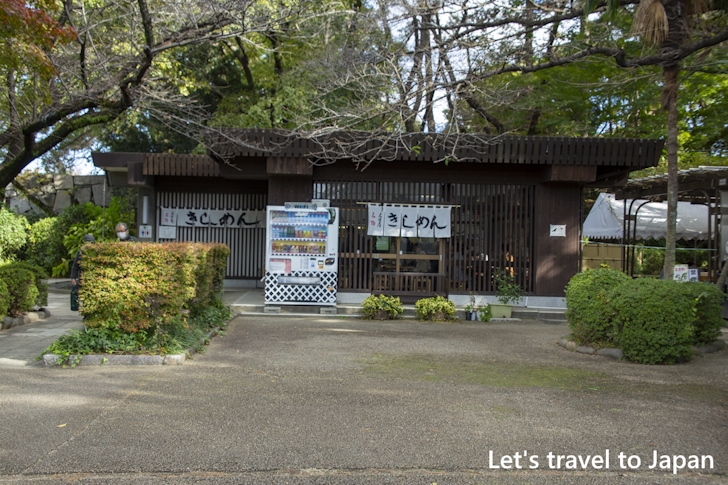
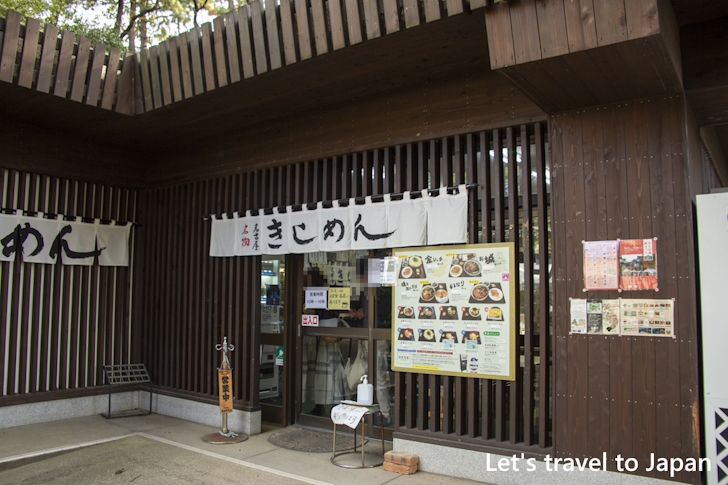
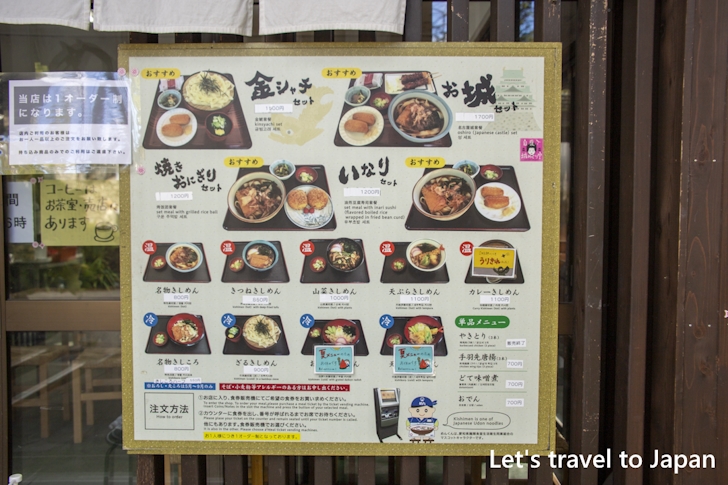
There are also other places for simple meals like dango, including (1) the cafeteria and shop next to the Seimon, (2) the inner garden shop, and (3) the satellite shop."
The cafeteria and shop next to the Seimon are located just after entering the Seimon, where you can enjoy mitarashi dango, gohei mochi, oshiruko, and more. Souvenirs are also available for purchase.
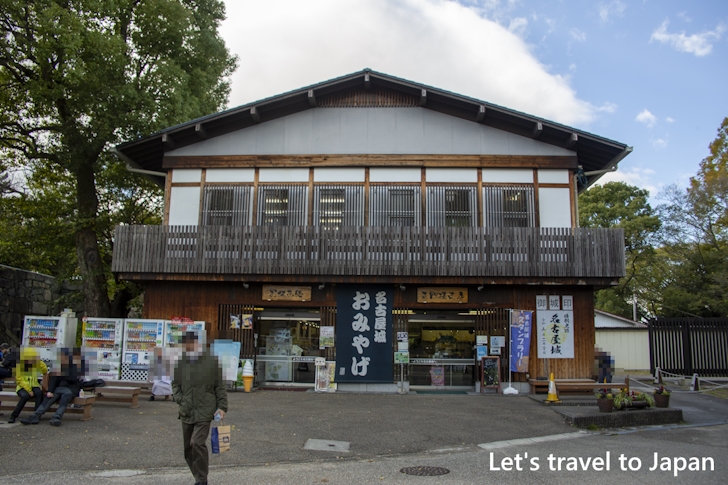
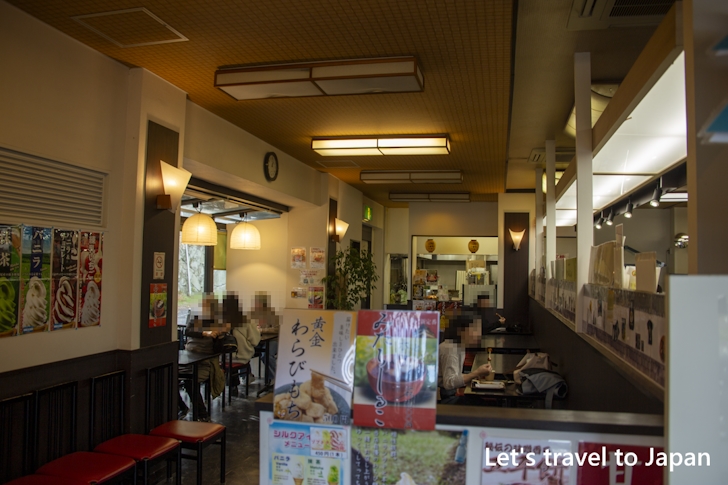
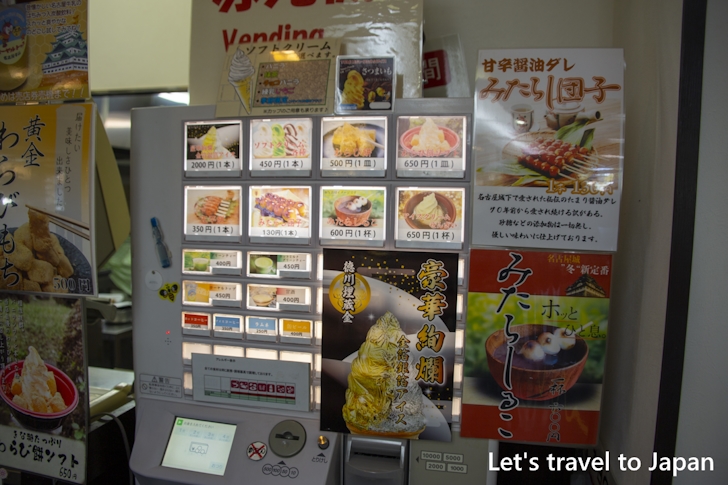
The inner garden shop, located in front of the castle tower, offers treats like gohei mochi and oshiruko.
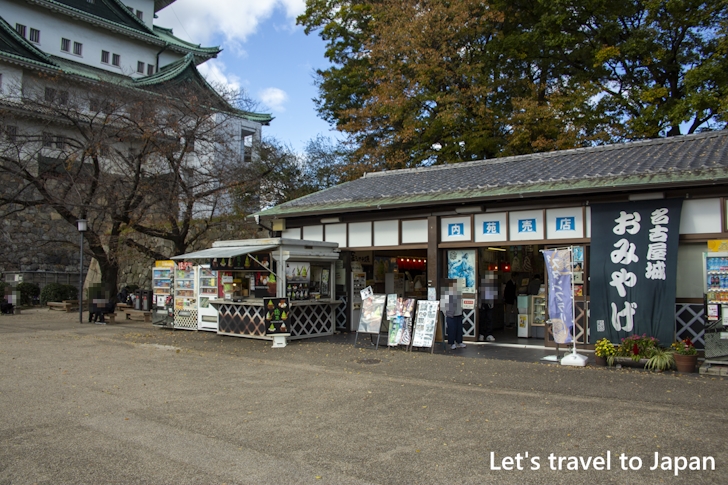
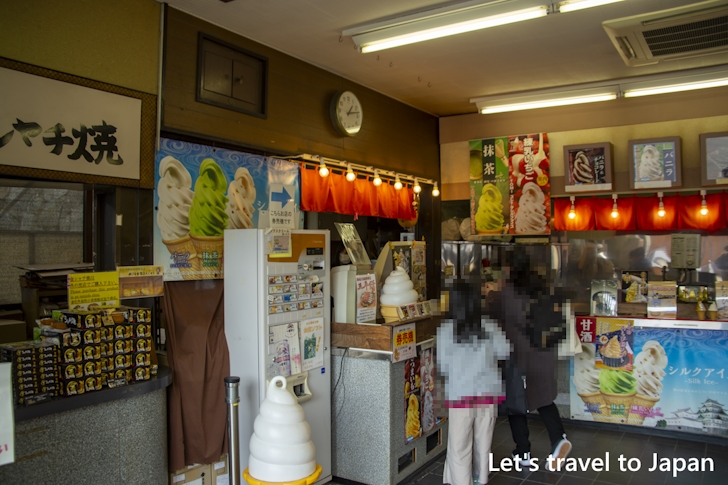
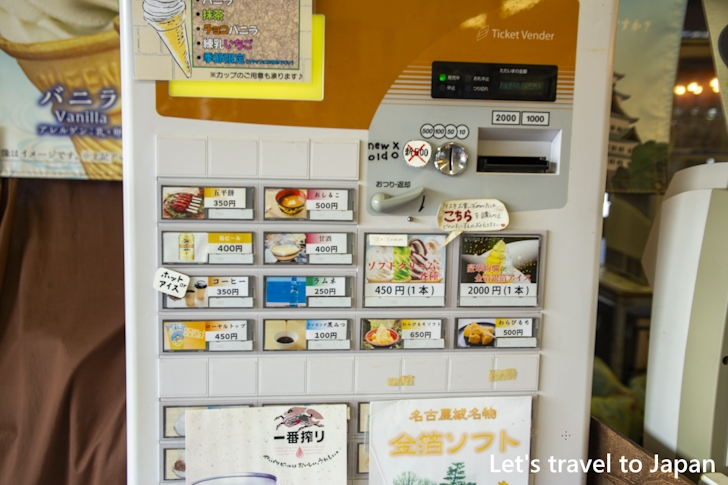
The satellite shop near the east gate also serves gohei mochi, mitarashi dango, and more.
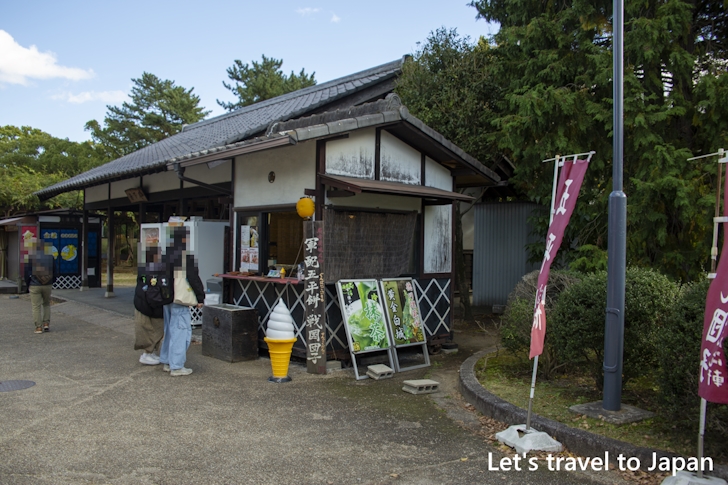
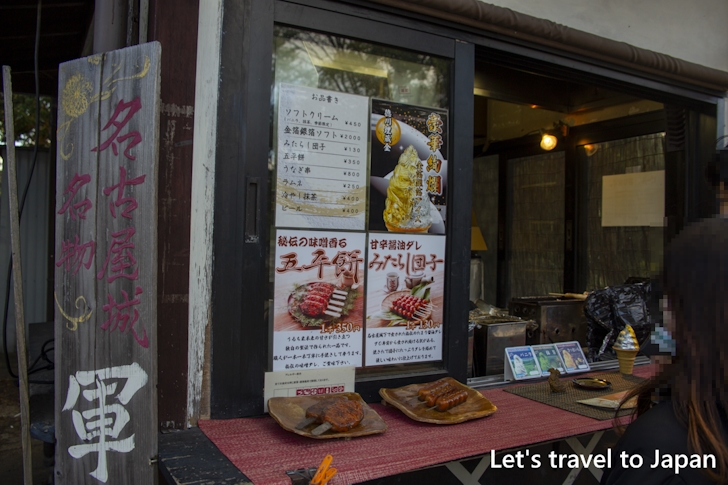
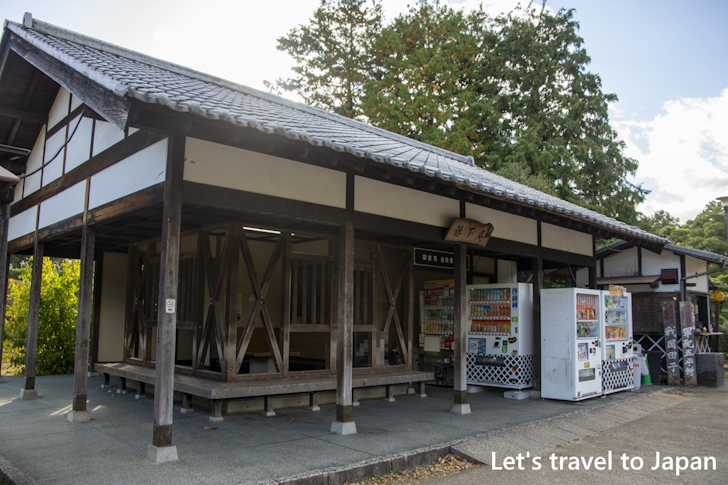
Additionally, at the Ninomaru Teahouse located in the Ninomaru Garden, you can enjoy matcha and mitsumame.
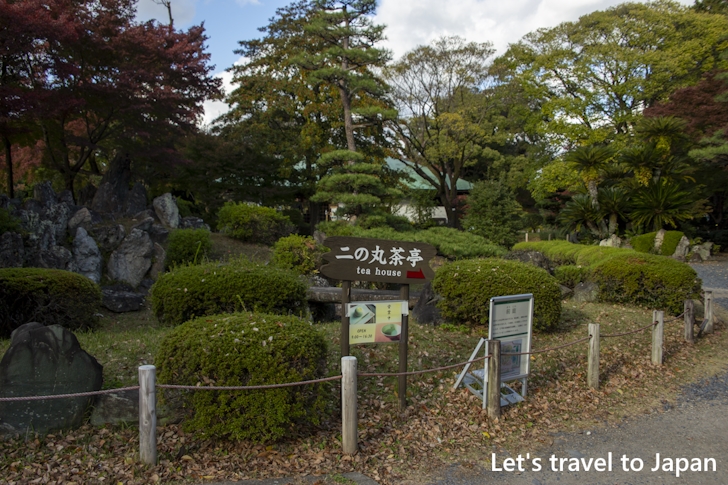
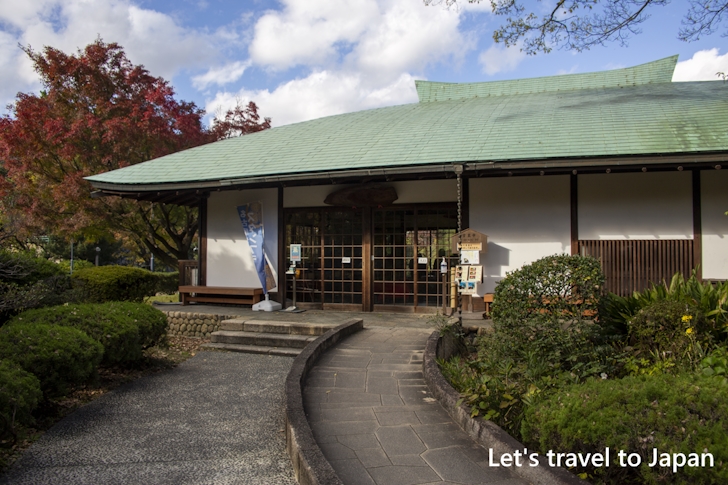
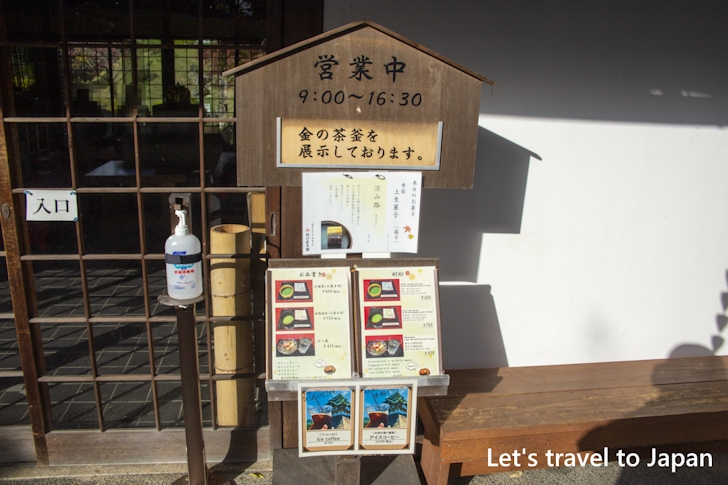
Kinshachi Yokocho
Kinshachi Yokocho is an area near Nagoya Castle, bustling with restaurants and souvenir shops. In the Yoshinao Zone near the main gate, there are 12 stores, and in the Muneharu Zone near the east gate, there are 8 stores. You can dine inside these shops or take out food for a stroll. Both zones are located outside of Nagoya Castle, allowing free entry and exit.
For more detailed information about Kinshachi Yokocho, please see 「Complete Guide to Lunch & Eating Around Kinshachi Yokocho」.
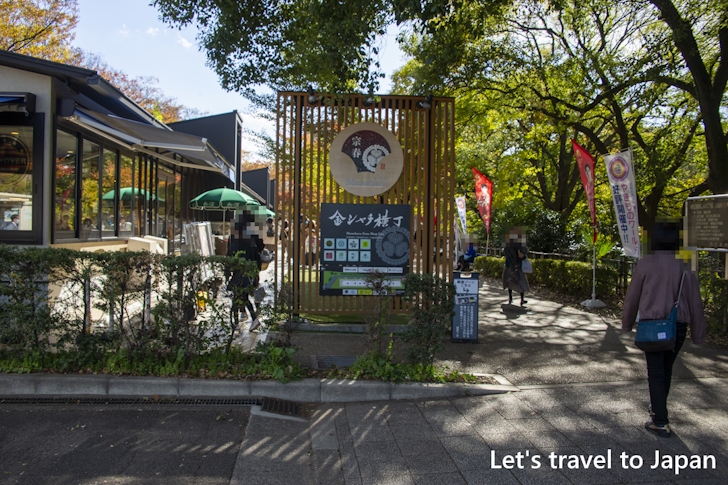
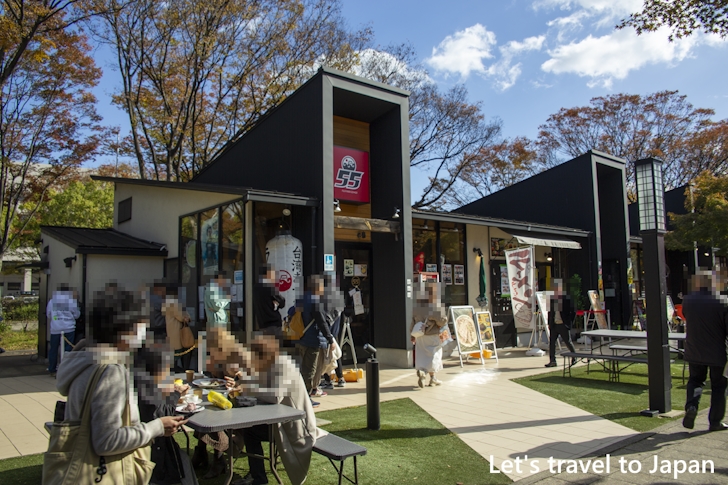

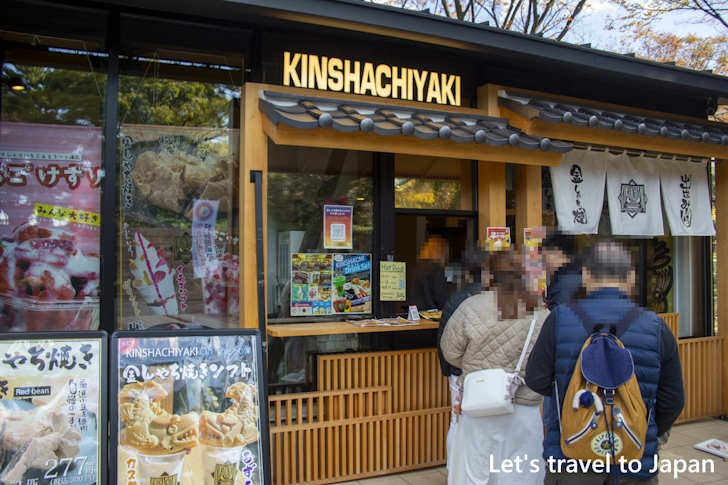
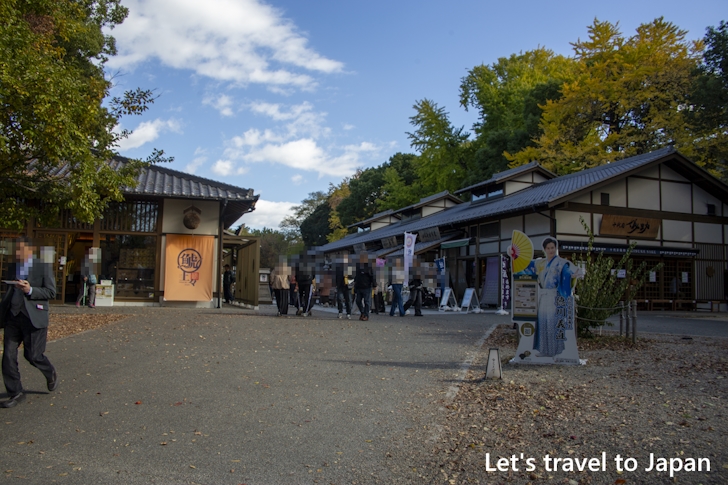
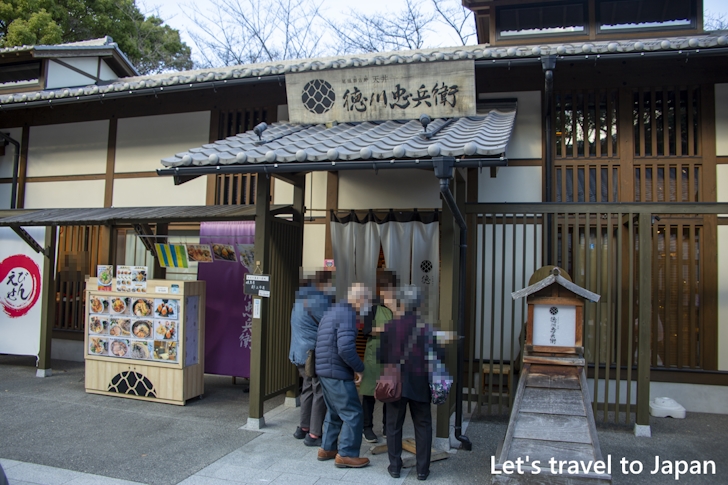
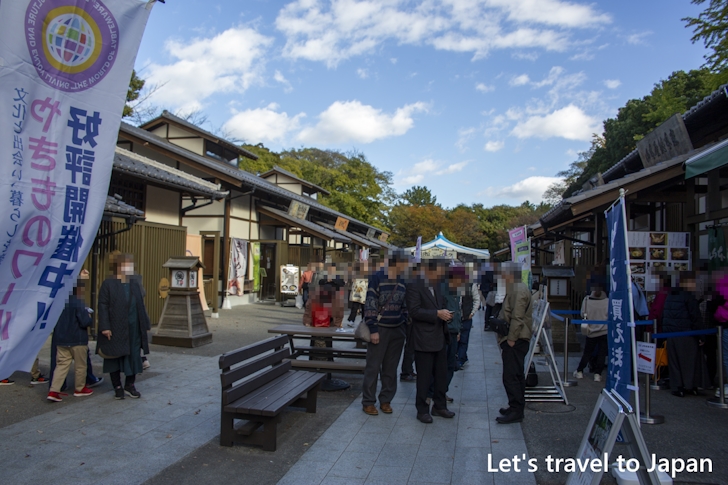
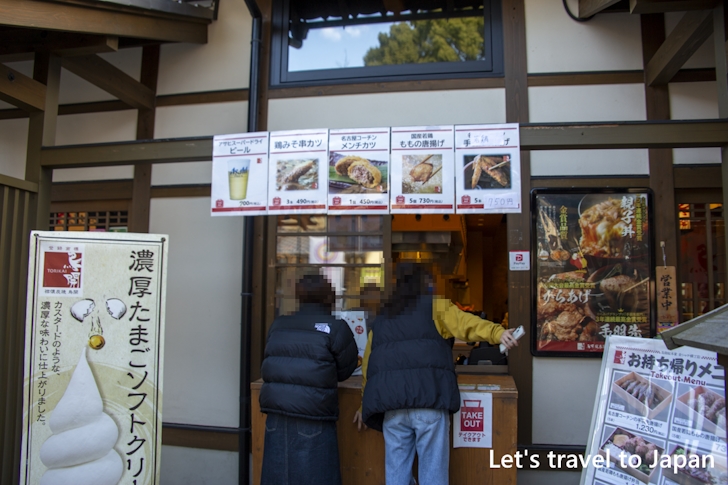
Meijo Park
Meijo Park is a castle park adjacent to Nagoya Castle. Within its vast grounds, there are lawns and ponds, allowing visitors to relax while enjoying the scenery of each season. The park features attractions such as a Dutch-style windmill in the lawn area, Flower Plaza which hosts exhibits and workshops about flowers and greenery, and the commercial facility 'tonarino' which includes restaurants and cafes.
Generally, when referring to Meijo Park, it is the North Garden area, known for its lawn park, that is being referred to. However, the area with Nagoya Castle is the South Garden of Meijo Park, and Nagoya Castle is also a part of Meijo Park.
For more detailed information about Meijo Park, please see 「Highlights and access methods of Meijo Park」.
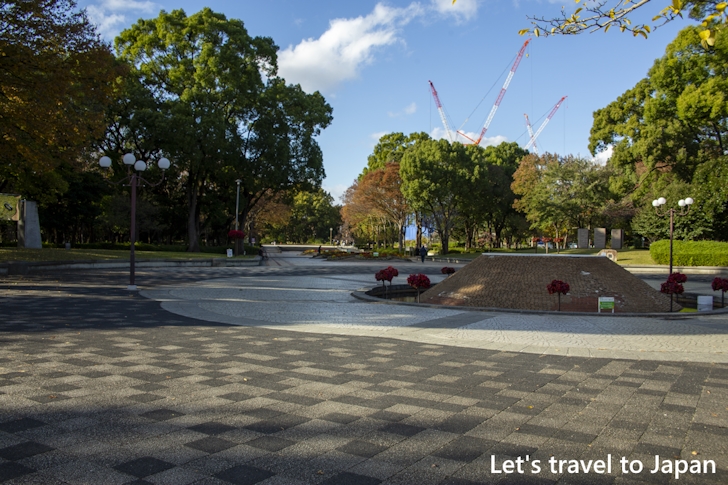
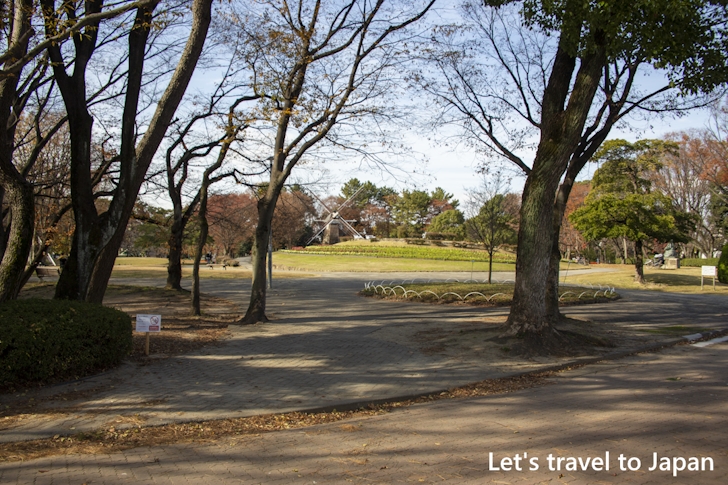
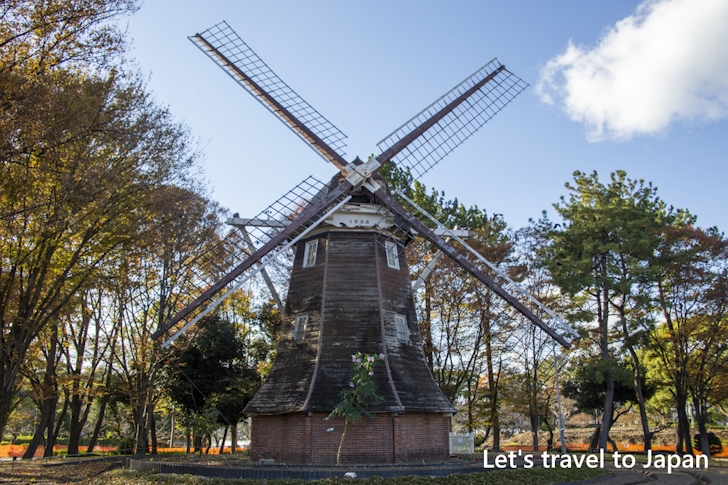
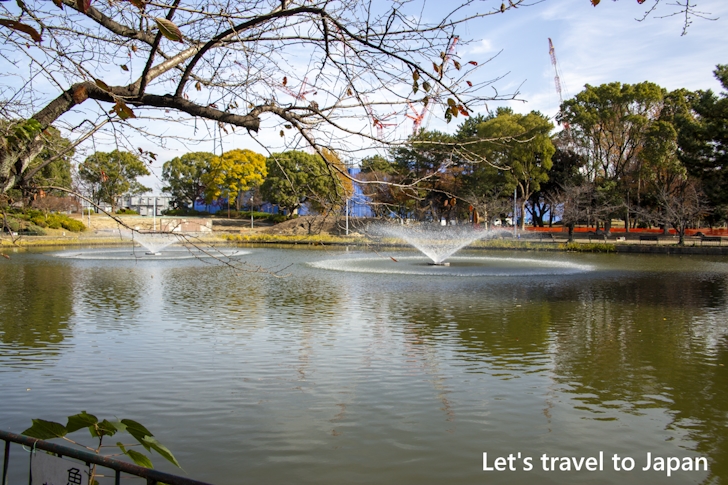
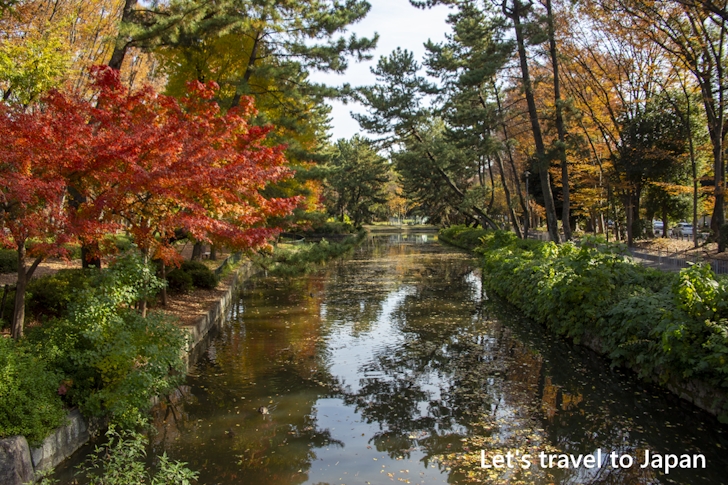
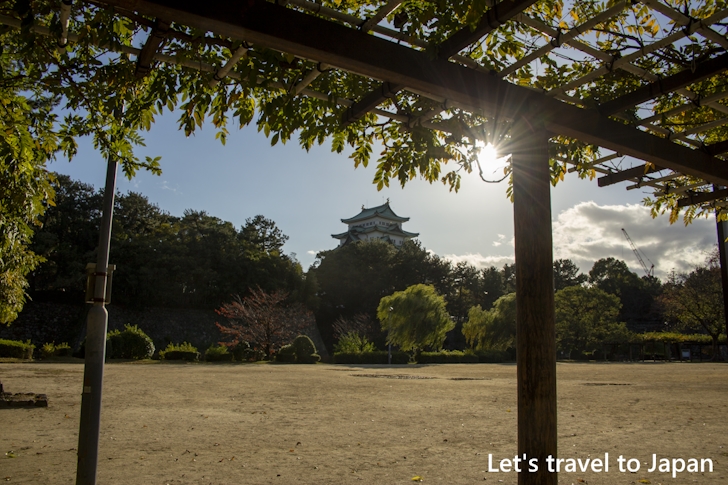
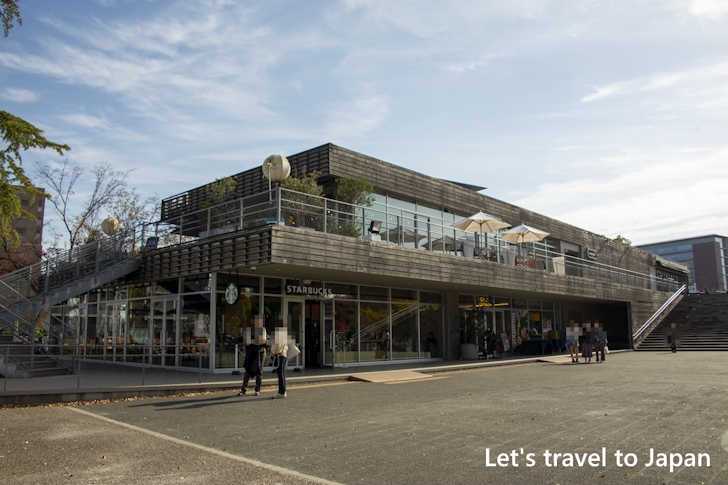
Snowy landscape of Nagoya Castle
This is the snowy landscape of Nagoya Castle.
For more detailed information about snowy landscape of Nagoya Castle, please see 「Complete guide to the highlights of snowy landscape of Nagoya Castle」.
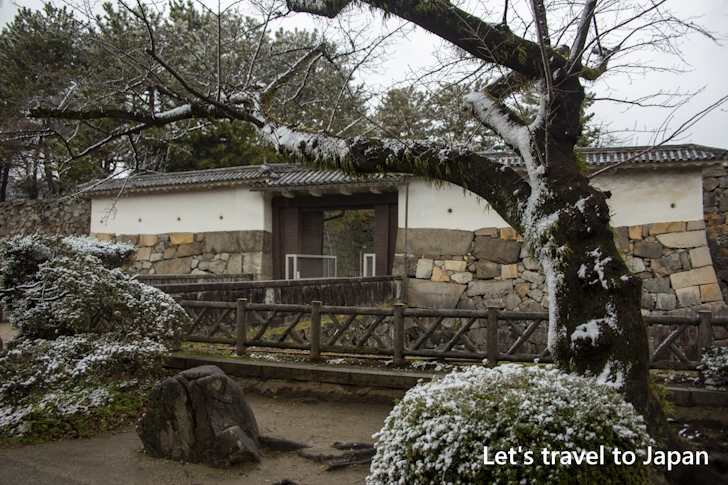
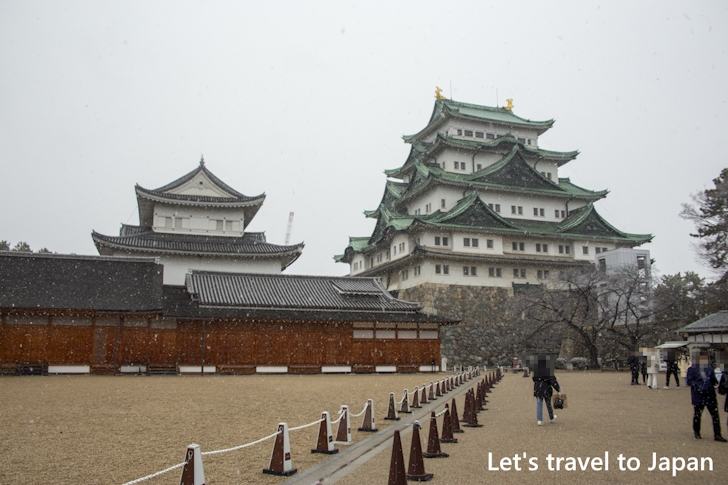
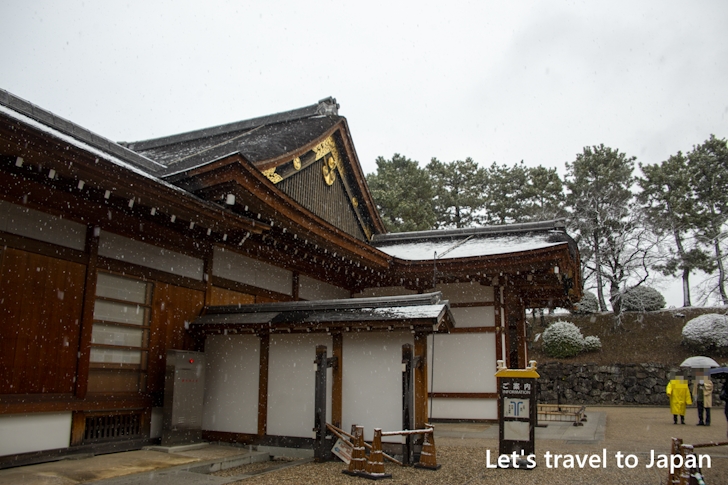
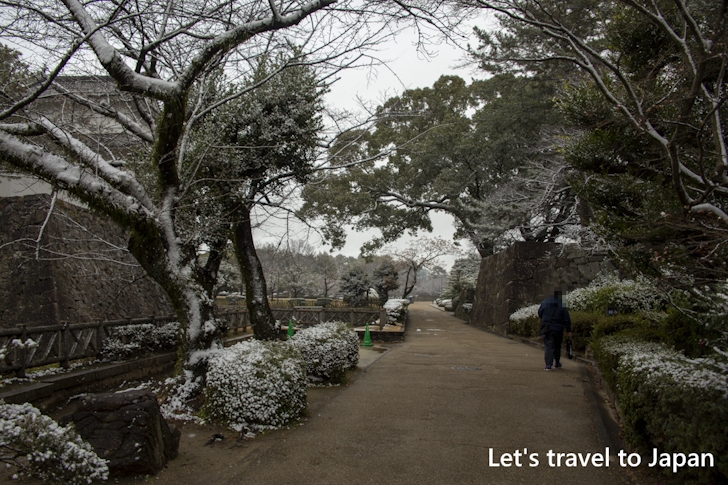
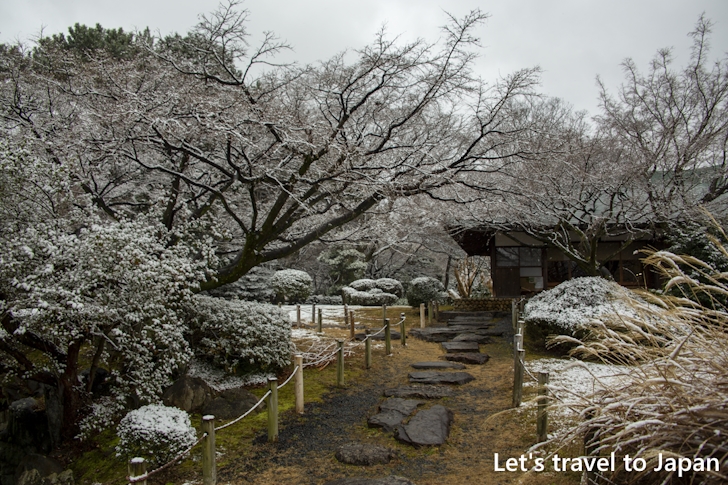
List of photos related to Nagoya Castle
Please see below for a list of photos related to Nagoya Castle.
Address and access method of Nagoya Castle
Address of Nagoya Castle
The address of Nagoya Castle is "1-1 Honmaru, Naka-ku, Nagoya, Aichi Prefecture".
Access method of Nagoya Castle
I will explain how to access Nagoya Castle from Nagoya Station.
Nagoya Municipal Subway Higashiyama Line
5 minutes
Nagoya Municipal Subway Meijo Line Clockwise
4 minutes
Walking
5 minutes
Nagoya Castle parking lot
Nagoya Castle has 2 paid parking lots. For information on the location of each parking lot and how to access it, please see 「Complete guide to parking at Nagoya Castle」.
While they are not designated parking lots, there are several roads around Nagoya Castle where street parking is possible on certain days of the week. For information on roads where street parking is available, please refer to 「Free street parking roads around Nagoya Castle」.
Attractions near Nagoya Castle
Several notable attractions are located near Nagoya Castle:
Higashiyama Zoo and Botanical Gardens
Higashiyama Zoo and Botanical Gardens is a municipal zoo and botanical garden located in Nagoya, Aichi Prefecture. It opened in 1937. Within the grounds, there are not only a zoo and botanical garden but also an amusement park, a natural animal museum, a world medaka museum, an petting zoo, and an observation deck called the Higashiyama Sky Tower. In addition to its convenient location just a few minutes' walk from the subway station, admission is free for junior high school students and younger, making it a popular spot for families.
Little World Museum of Man
Little World is an open-air ethnographic museum featuring 32 houses from 23 different countries. Visitors can explore buildings that have either been relocated or restored from various countries and can also enjoy cuisines from around the world. In some areas, you can try on traditional ethnic clothing and take a stroll or snap photos within designated areas while wearing the attire. Regular events and fairs are held, making it enjoyable no matter how many times you visit.
Dino Adventure Nagoya
Dino Adventure Nagoya is a dinosaur-themed amusement park located within the Odaka Ryokuchi Park in Nagoya, Aichi Prefecture. The park features a self-guided walking course through a forest where numerous lifelike dinosaurs are placed. Each of these dinosaurs moves and makes sounds, offering visitors an experience as if they have stepped into a prehistoric world.
LEGOLAND Japan
LEGOLAND Japan is a LEGO brick-themed amusement park located in Nagoya, Aichi Prefecture. The rides and attractions within the park are designed to resemble structures made out of LEGO bricks. Additionally, numerous objects created from LEGO bricks are installed throughout the park. Adjacent to the park are SEA LIFE Nagoya, an aquarium facility, and the LEGOLAND Japan Hotel, which offers accommodation.
Other information about Nagoya Castle
Official site about Nagoya Castle :
https://www.nagoyajo.city.nagoya.jp/
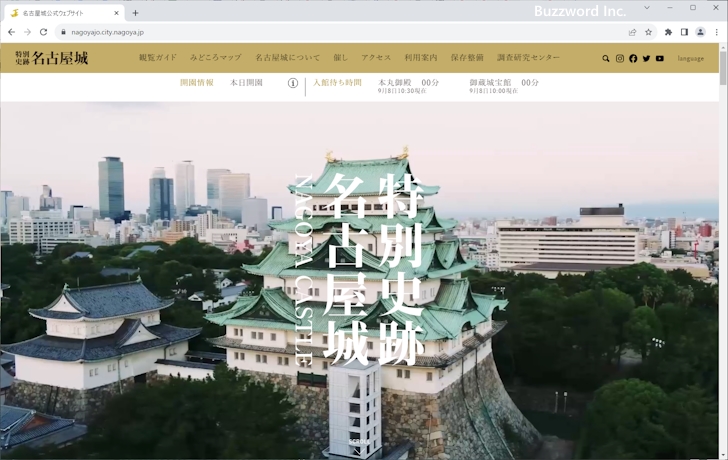
-- --
Thank you for reading to the end.
( Written by Tatsuo Ikura )